Some people have a taste for the mundane, others are fascinated with the peculiar. If you’re one of the latter ones like me, pull your seat closer. Welcome to the “The Museum of Ridiculously Interesting Things,” which is an imaginary online museum that stretches between a website, Instagram and Twitter accounts, and a Facebook page with an audience of 53k strong.
Written by curator and historian Chelsea Nichols, The Museum of Ridiculously Interesting Things started out in 2011 as her personal blog. It was relaunched three years ago as an umbrella site for a series of digital, curatorial and writing projects dedicated to making the world a weirder and more interesting place. Today, it’s a treasure box that explores the strange place between art and curiosities.
Below we selected some of the most intriguing examples shared, or rather exhibited, at The Museum for your amusement!
#1 Persian Cat Sabotaged Before A Cat Show In Milwaukee, Wisconsin In 1949
According to her owner, Petite Lilly Bear was smeared with makeup by an unknown assailant in the hours before a Sunday morning cat show, ruining her chances of winning. She was moved to tears by the incident. (The owner was, not the cat. The cat was a model of stoic dignity in the face of such terrible adversity.) Photograph by Powell Krueger, from Hennepin County Library Digital Collections.
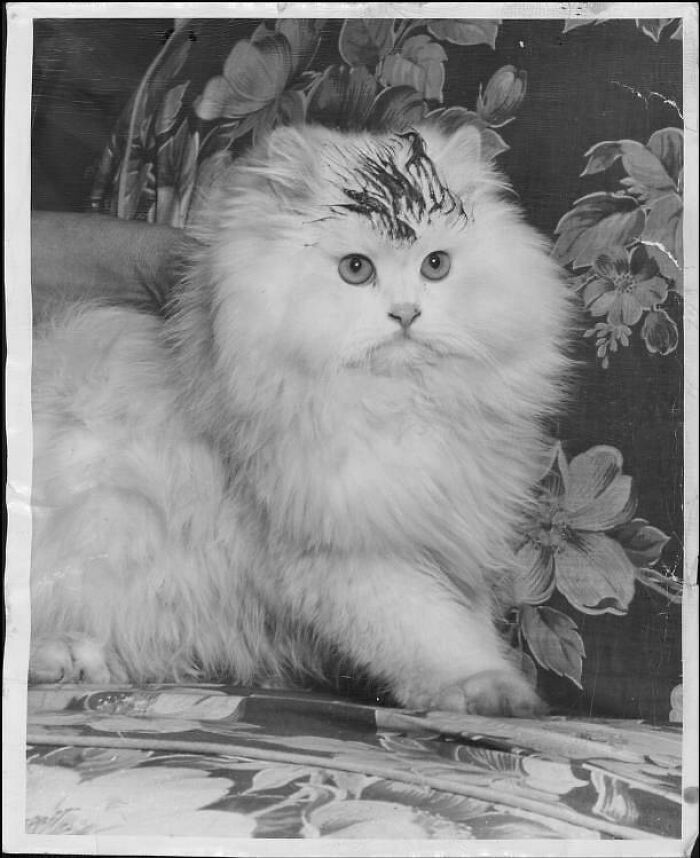
Image credits: The Museum of Ridiculously Interesting Things
#2 Boots Worn By Children Who Were Struck By Lightning At St Eata's Church In The Village Of Atcham In Shropshire, England On 13 July 1879
The children were apparently not seriously injured
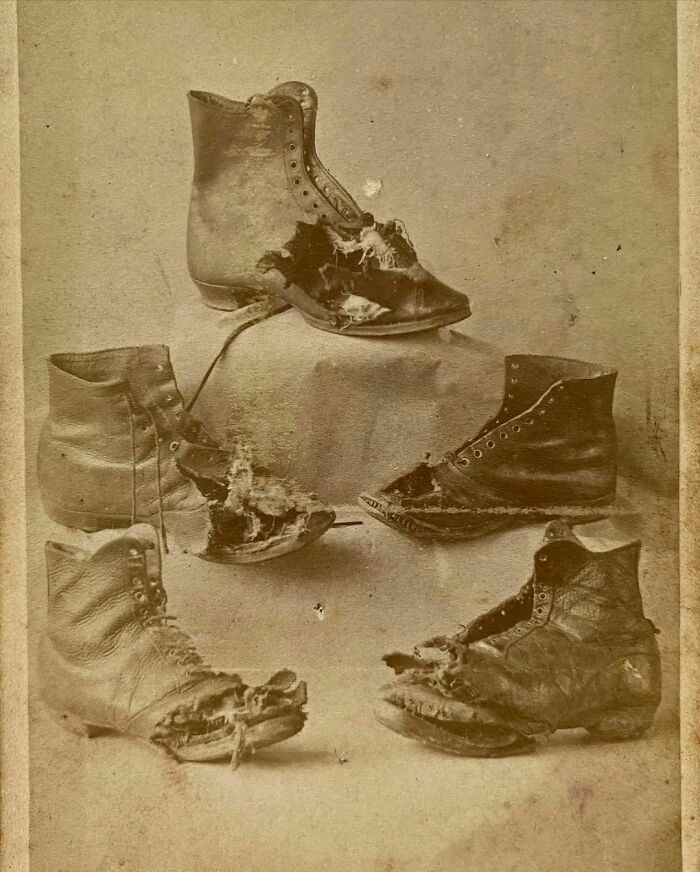
Image credits: The Museum of Ridiculously Interesting Things
#3 A Neon Salesman's Sample Case, Circa 1935
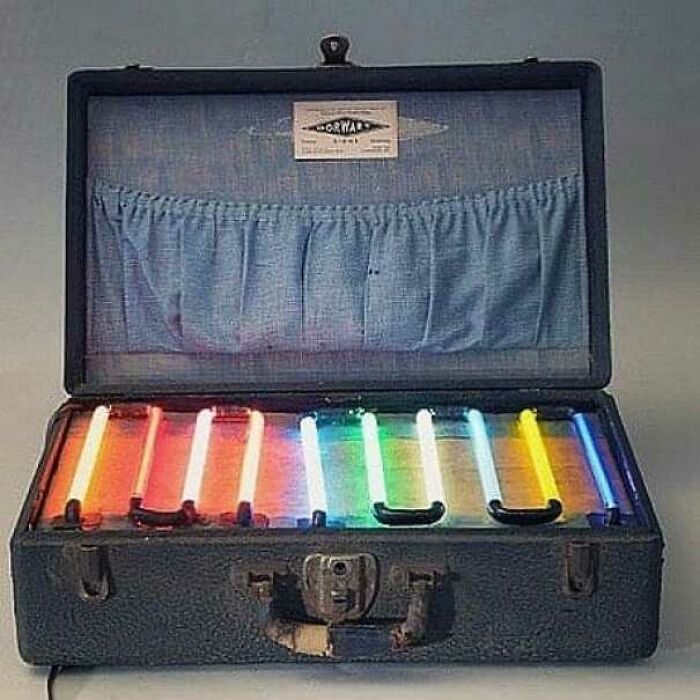
Image credits: The Museum of Ridiculously Interesting Things
#4 Ok, Are You Ready To Cry? About 4500 Years Ago, Ancient Egyptian Parents Put This Homemade Ball In Their Child's Grave As A Toy For The Kid To Play With In The Afterlife
It is made from old linen rags tied up with string, and was probably not made specifically for the burial -- rather, the ball was more likely something that the child loved and played with during their short life. This kicks me right in the damn guts. It's from the collection of the Bristol Museum and Art Gallery, where I assume the label does not say "Ancient toy stolen from a well-loved dead kid" but maybe it should.
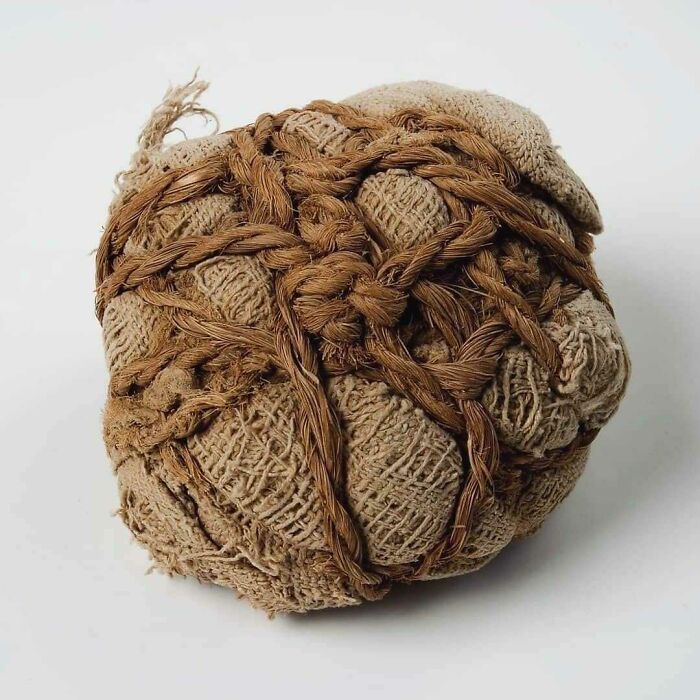
Image credits: The Museum of Ridiculously Interesting Things
#5 Screaming Baby Dolls Made From Bisque Porcelain By German Dollmaker Kestner Around 1920
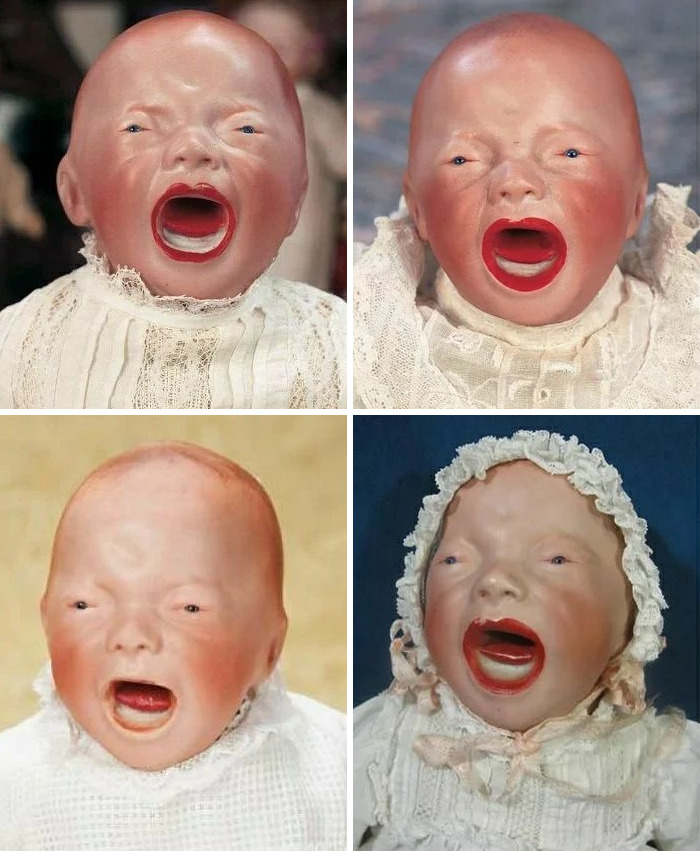
Image credits: The Museum of Ridiculously Interesting Things
#6 Dummy Head Used By Scientific Educators Around The Turn-Of-The-Century To Demonstrate Static Electricity
The demonstrator would rub the metal pole at the bottom with his hands, generating a charge that would travel up through the dummy head and make its hair stand on end. Here are the answers to the questions I know you'll all be asking about this: - Yes, that is real human hair. - No, I do not know whose hair it is. - No, to the best of my knowledge the dummy did not ever come to life and seek revenge on the scientists who had given him so many bad hair days. - Yes, you probably do recognize his face from that recurring nightmare that you have about getting murdered behind a gas station. - No, I do not know why they did not paint eyelids on him, and yes of course his unblinking stare pierces my soul and fills me with a sense of cold existential dread. - No, I do not know where you can buy one, you utter lunatic.
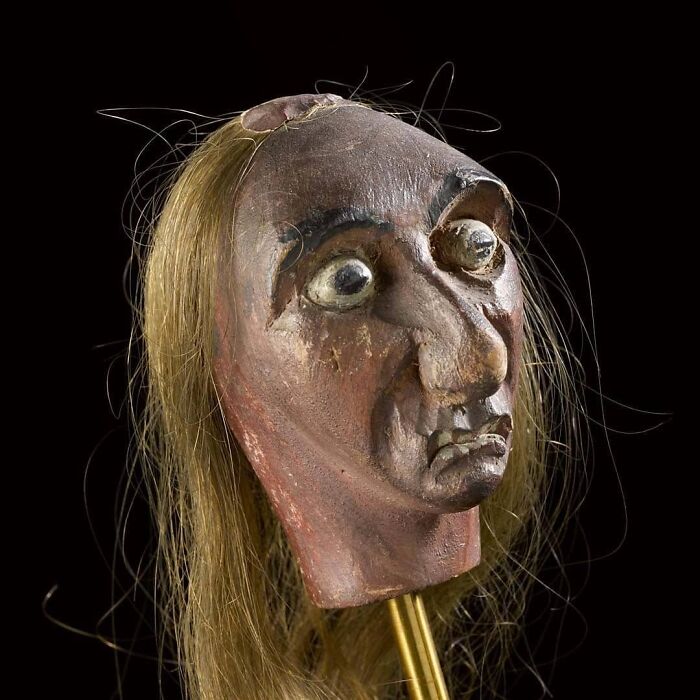
Image credits: The Museum of Ridiculously Interesting Things
#7 Shoe Doll That Belonged To A Child In The Slums Of London In The Early 20th Century
It is handmade from fabric scraps and the heel of a man's dilapidated shoe, with hair made from an old black sock. This doll belonged to an unnamed little girl living in Bethnal Green around 1905. It was acquired by the English folklorist Edward Lovell, who would buy poor children new toys in exchange for their makeshift ones. Although Lovett is perhaps best known today for his collections of folk charms and amulets, he also amassed a huge collection of homemade dolls and games in an attempt to preserve the material culture and history of London's poorest and most vulnerable people. However noble those intentions, I find the collection of this shoe doll unbearably sad. Rather than exchange it for a new toy, Lovett gave the child and her family a sum of money in exchange for this doll. She selflessly gave up her ONE crude toy to help out her desperately impoverished family. From The Museum of Childhood, Edinburgh.
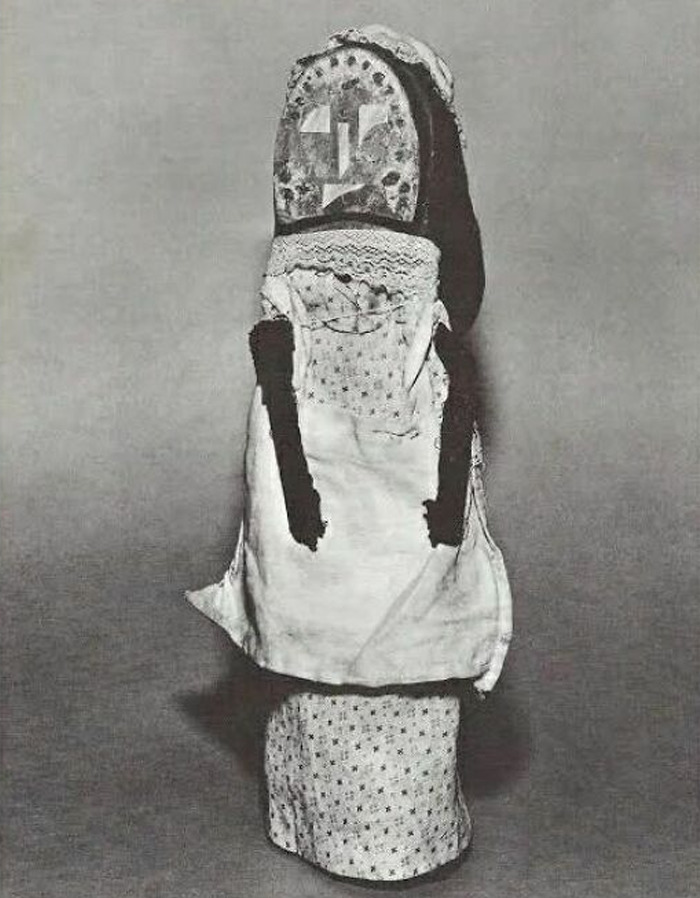
Image credits: The Museum of Ridiculously Interesting Things
#8 Hans Eijkelboom, 'With My Family' (1973)
For this series, the Dutch photographer would ring the doorbells of strangers' houses after he saw the husbands leave for work. He would then convince their wives to pose in a family portrait with him in the place of the father. Another title for this series might as well be "Portrait of women who definitely don't listen to a lot of true crime podcasts."

Image credits: The Museum of Ridiculously Interesting Things
#9 Rosamond Purcell's Unsettling Photographs Of Monkey Specimens With Cotton Ball Eyes, From The Collection Of Harvard's Museum Of Comparative Zoology
They look exactly like the things that stand outside your bedroom window at night watching you sleep. Sweet dreams.
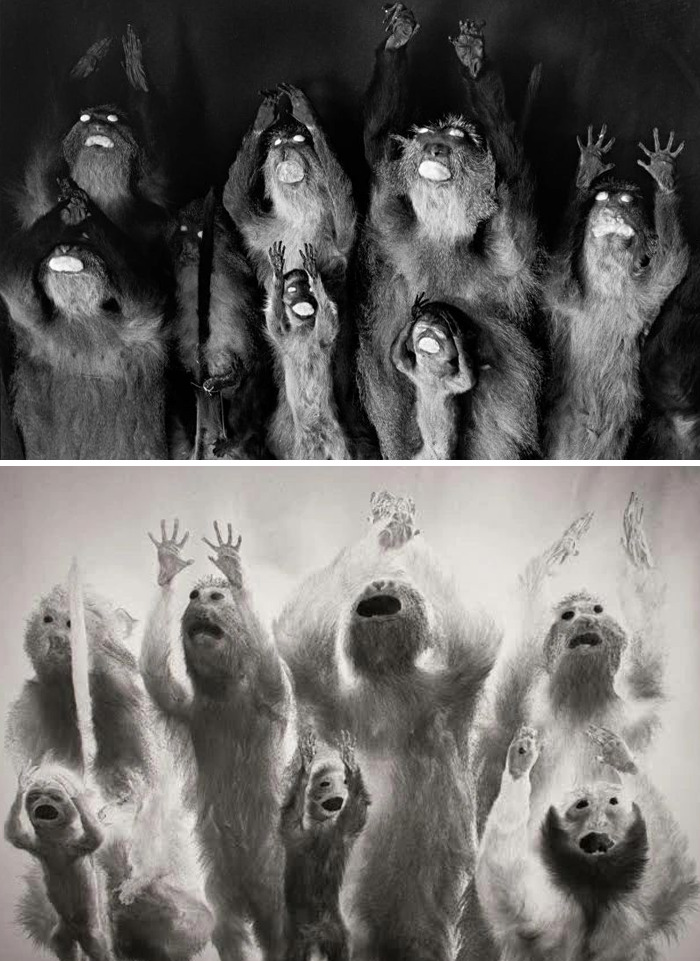
#10 Late Victorian Art Pottery Known As Martinware, Which Depicts A Horrifying Crab With A Grotesque Human Face
Made by Robert Wallace Martin in June 1880, from salt-glazed stoneware. In London in the late 19th century, Martin and his three eccentric brothers made and sold strange, Gothic-inspired pottery sculptures -- now highly sought-after by collectors around the world. This creepy smiling crab is considered the pinnacle of their unique style...so much so that the UK actually banned it from being exported from the country for sale last year because it was deemed to be of such high national significance. Although I LOVE the grotesque I still found this ruling quite surprising, considering that (according to professional art historical opinion) this thing resembles: - a leftover troll costume from the 1991 movie Ernest Scared Stupid - a bag of sick with a face - a Jim Henson puppet that was horribly disfigured in a grease fire - what happens if you anger a sea witch - Jabba the Hutt trying on dentures - me when I open my camera phone by mistake - the stuff that grows at the bottom of unwashed lunch containers when you forget to take it out of your backpack for a few weeks After it was banned from leaving the UK, this crab was purchased by The Box, a new museum and gallery opening in Plymouth, where this nightmare in the shape of a crustacean will surely traumatize delighted visitors for years to come.
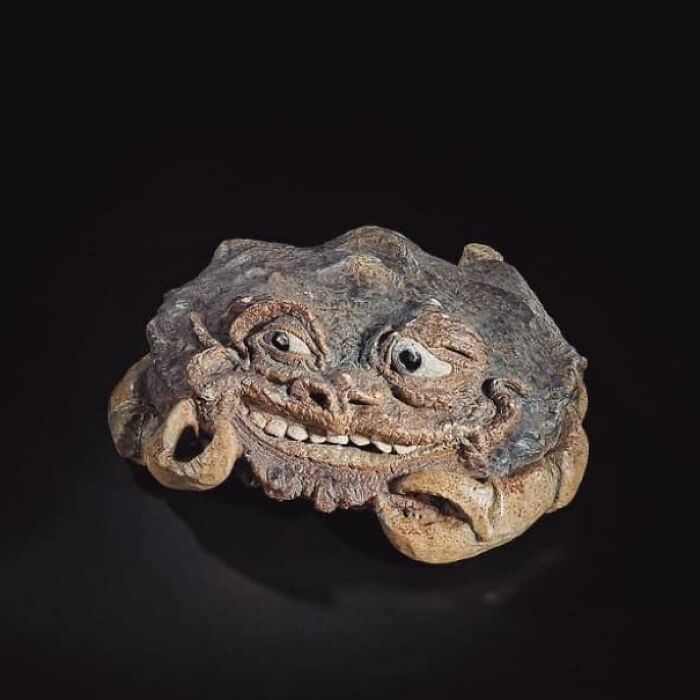
Image credits: The Museum of Ridiculously Interesting Things
#11 Hendrick De Keyser (1565-1621) Was A Dutch Sculptor And Architect Inspired By The Timeless And Majestic Beauty Of A Screaming Baby's Forehead Veins
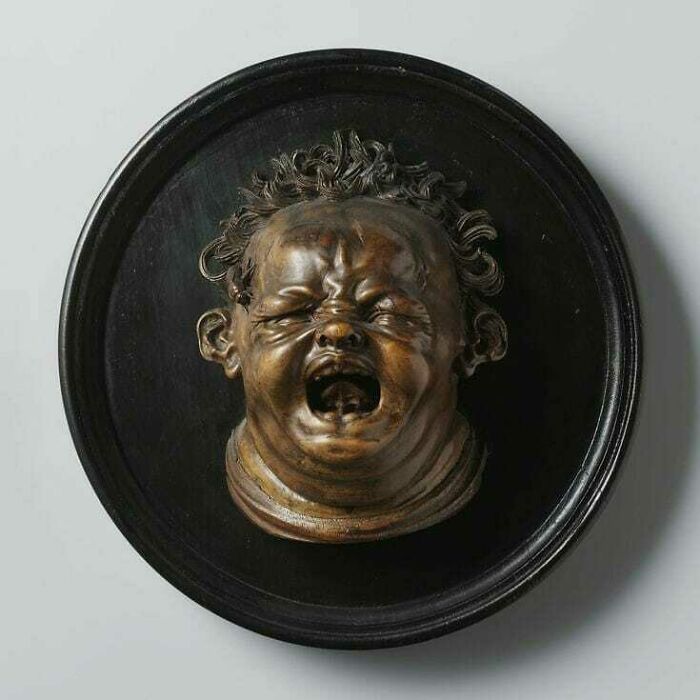
Image credits: The Museum of Ridiculously Interesting Things
#12 The Impression Of A Supernatural Face In A Tray Of Putty, Made By Italian Psychic Eusapia Palladino (1854-1918)
She claimed to have produced the faces using telekinesis during a seance in 1897, while her hands were bound behind her back. Skeptics noted that the facial imprints looked exactly like Palladino and her male assistant, rather than the ghosts that she was supposedly channeling.
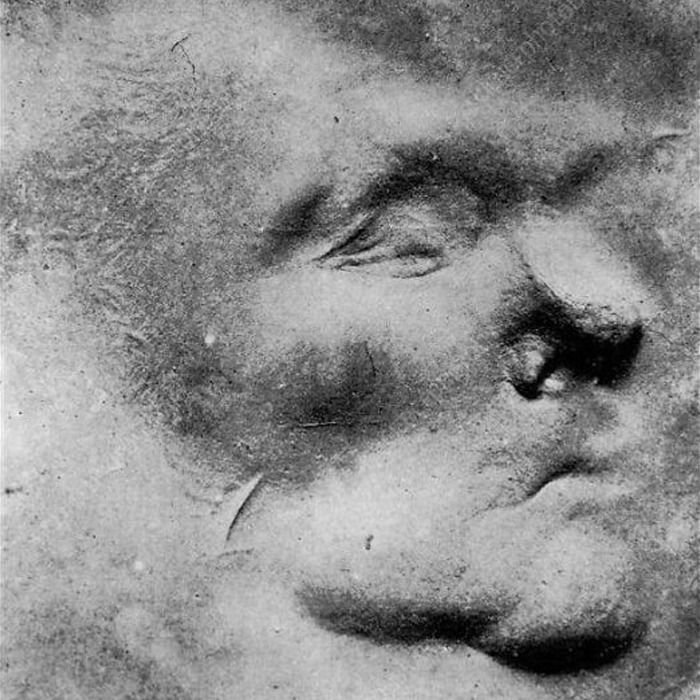
Image credits: The Museum of Ridiculously Interesting Things
#13 An Antique Bear Automaton Whose Fur Was Destroyed By An Infestation Of Moths
The creepy naked bear pours itself a big drink with shaky paws, tossing the whole thing back in a single gulp. The magical drink never runs out thanks to a hidden tube mechanism that runs through its arms
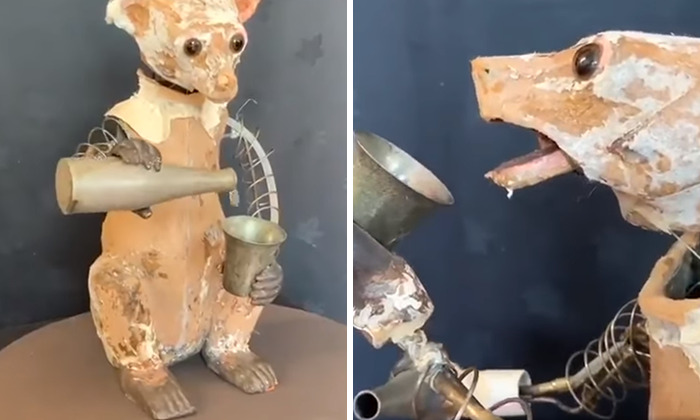
Image credits: The Museum of Ridiculously Interesting Things
#14 When The Lid Is Opened On This Victorian Gold Charm, A Little Demon With Sparkling Rhinestone Eyes Pops Out
These (frankly adorable) devil totems were worn as symbols of temperance -- a reminder to resist the sinful temptation of drinking alcohol. Probably made in the US, circa 1880.
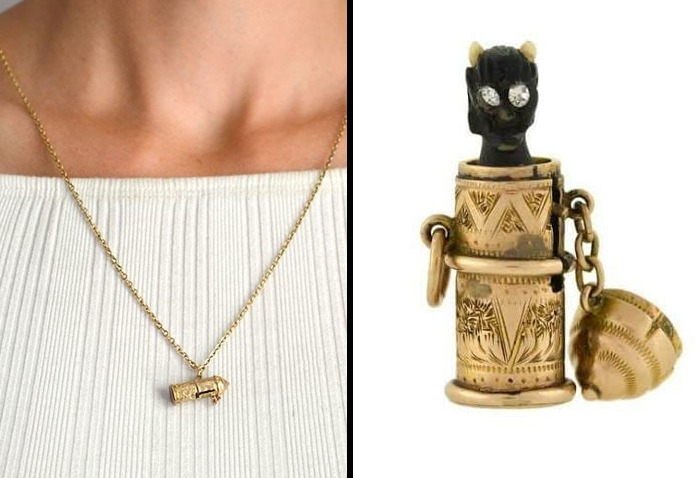
Image credits: The Museum of Ridiculously Interesting Things
#15 A Witch Whistle Or 'Heksenfluit' Made From A Rat's Paw And Carved Bone
Made in 19th century Belgium, and purchased by the Museum aan de Stroom in Antwerp in 1964. I've seen this described on the internet as a flute used to summon witches on the Sabbath. However, according to the museum, this magical flute was actually used to dispel diseased rodents during a rat plague. (Which is possibly even weirder?) During the mid-19th century, the third wave of bubonic plague swept the world, transmitted by fleas on infected rats. It hit China and India particularly hard and spread to port cities on trading routes with them. Antwerp, however, wasn't too badly bedeviled by the plague. Thanks, rat flute! Definitely all you
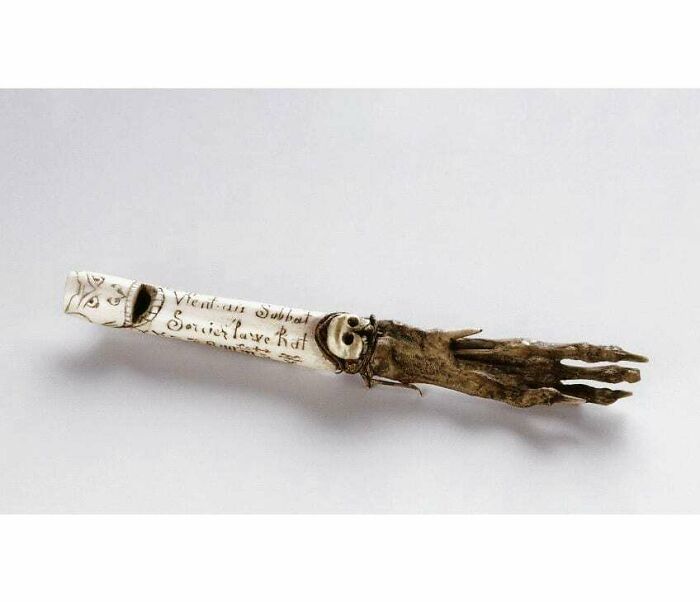
Image credits: The Museum of Ridiculously Interesting Things
#16 Willem Frederik Van Royen, 'The Carrot' (1699), Oil On Canvas. Märkisches Museum, Berlin
The Dutch Golden Age gave us masterpieces like Vermeer's 'Girl With A Pearl Earring' (c. 1665) and this painting of a deformed carrot man...which I think we can all agree achieves more or less the same level of breathtaking beauty.
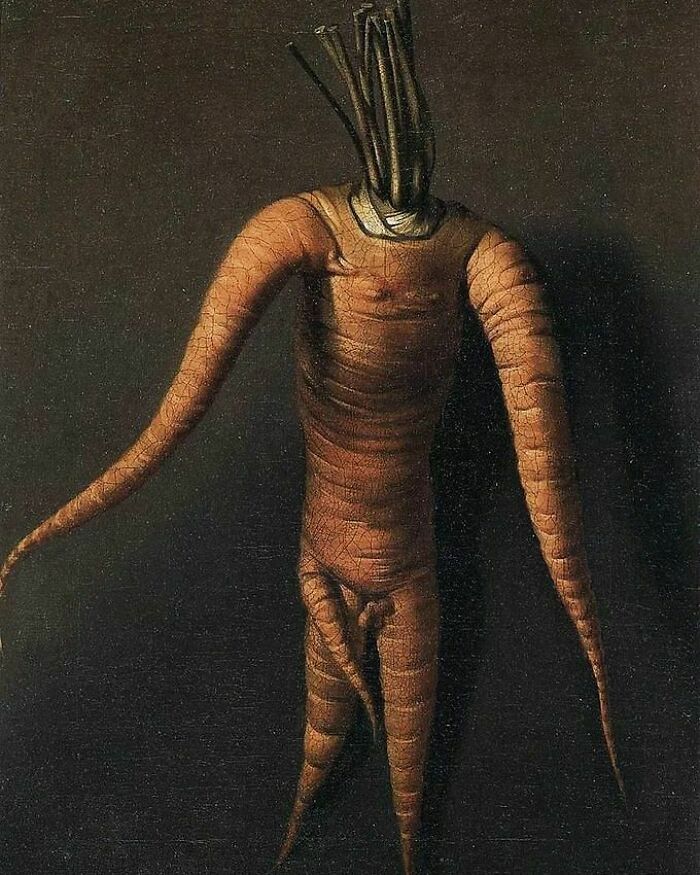
Image credits: The Museum of Ridiculously Interesting Things
#17 The 'St Dennistoun Mortuary', A Macabre Coin-Operated Automaton Made Around 1900
When a coin is inserted, the doors open to reveal morticians working on several dead bodies laid out on embalming tables. A nodding policeman observes the corpses in the middle, which are labelled "Believed murdered" and "Found stabbed." Outside the mortuary doors, two mourners dab their eyes with grief. The mortuary was made by John Dennison, who ran a business creating ghoulish penny slot machines and creepy mechanical fortune tellers (dream job?) to amuse Blackpool tourists at the end of the 19th century. His other machines included grisly scenes like executions, haunted houses, high-profile crimes, a dying child and drunkard in a graveyard.
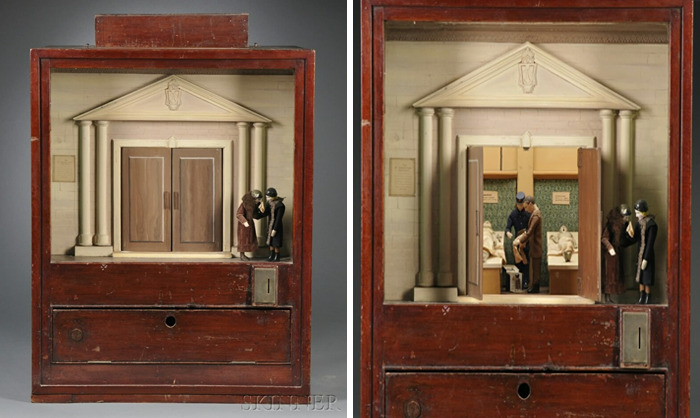
Image credits: The Museum of Ridiculously Interesting Things
#18 Terracotta Vase In The Shape Of A Lobster Claw, Made In Greece Around 450 To 400 Bc
Only nine of these strange ancient drinking vessels are known to exist. According to the Metropolitan Museum of Art, these lobster claws were most likely novelty cups used at symposia (drinking parties) in Ancient Greece. Unfortunately, the museum is not interested in expanding their novelty cup collection by acquiring the gently used Looney Tunes mugs I got at KFC in the early 1990s, even though they are also excellent for serving expensive wine.
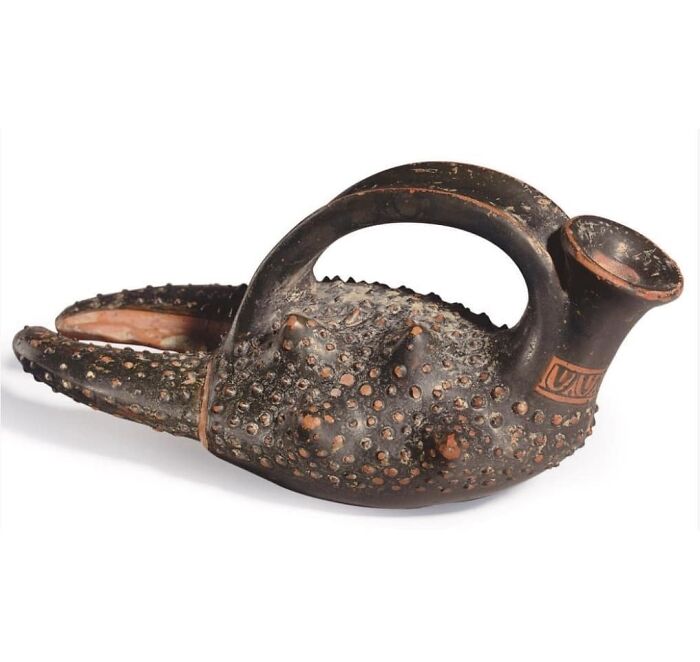
Image credits: The Museum of Ridiculously Interesting Things
#19 If You Need A Gift For A Child You Hate, Look No Further. These Creepy Chocolate Babies Were Made As Christmas Presents In 1923
Recently discovered in a chest of drawers by British auctioneer Charles Hanson. They survived nearly a century because obviously, they were too scary even for rats to eat. An accompanying note reads: "To the Frocue[?] girls With best Xmas wishes From Kitty Stanly Hall. OPEN WITH CARE - Oct 1923" The note does not explain why Kitty was giving out Christmas presents in October, nor does it suggest which part of the baby's face you were supposed to eat first.
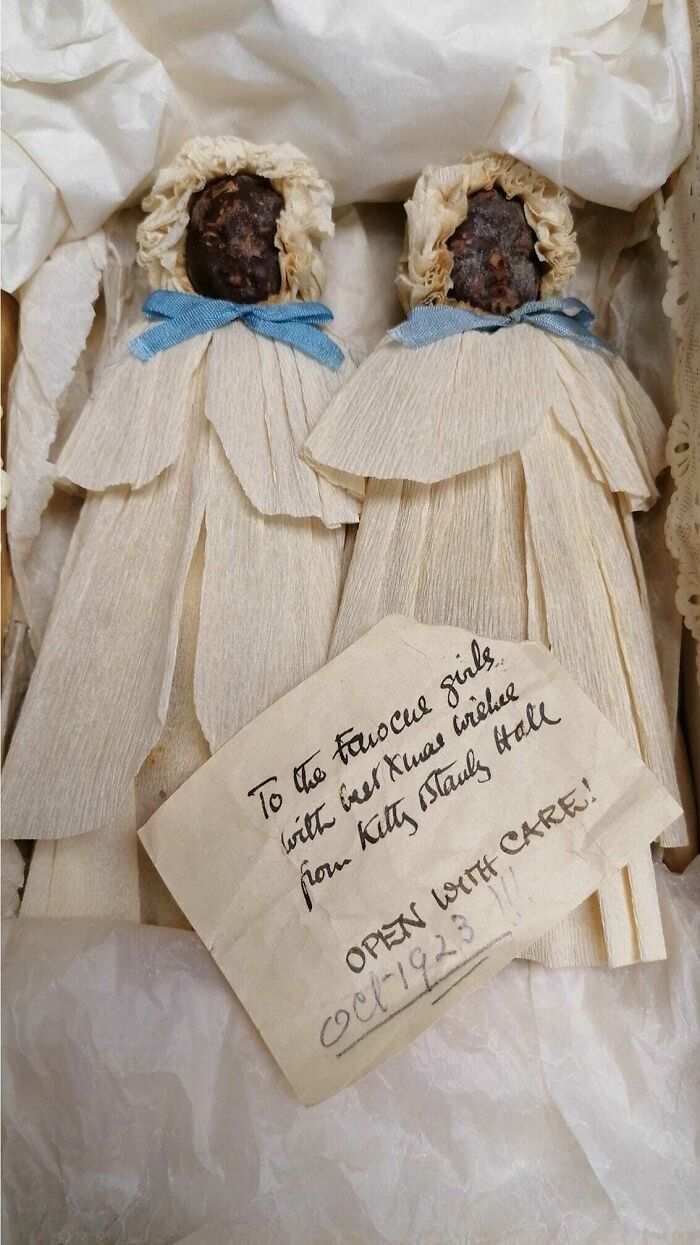
Image credits: The Museum of Ridiculously Interesting Things
#20 Hand-Coloured Photograph Of A Grown Man Feeding A Spooky Doll With A Spoon, C. 1864-66
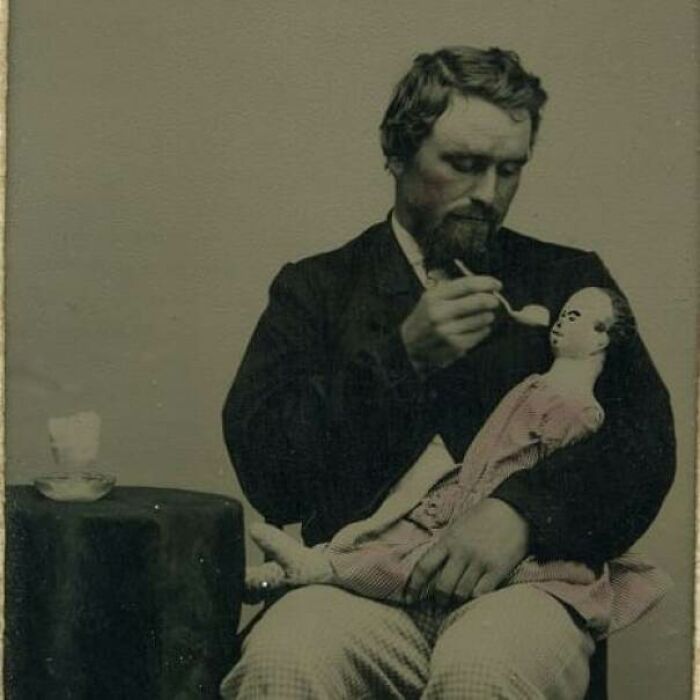
Image credits: The Museum of Ridiculously Interesting Things
#21 Why Are These Spooky Babies Wearing Different Wigs Of Real Human Hair?
These are all homemade collages using reproductions of a picture called "Heaven's Gift" by American illustrator Annie Benson Müller, which was mass-produced in the USA through the 1930s. Crafty mamas who couldn't afford an expensive baby book or studio portraits would glue locks of their baby's hair and scraps from christening gowns and baby blankets to these cheap illustrations -- a loving albeit slightly unsettling keepsake of their beloved babies. Individually, these creepy-cute hair babies are not TOO weird...but put them all together and they start to feel downright ghoulish. Credit to Victorian hair historian and artist Courtney Lane of Never Forgotten

Image credits: The Museum of Ridiculously Interesting Things
#22 A Bin Of Doll Heads Waiting To Have Their Eyelashes Trimmed
Photographed by NZ photographer Brian Brake at a Hong Kong doll factory in the 1970s. Collection of Te Papa Their weirdly long eyelashes tickle the part of my brain that makes nightmares
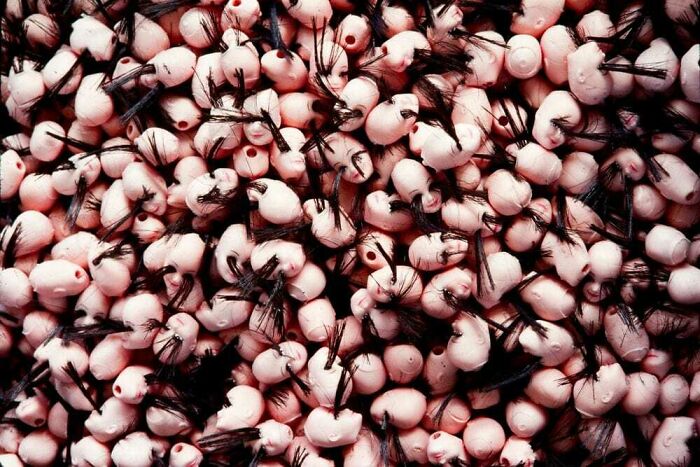
Image credits: The Museum of Ridiculously Interesting Things
#23 Why Does This Cindy Sherman Work Creep Me Out So Much? I Don't Really Have A Good Antswer
Cindy Sherman, Untitled (1989), colour duratrans in lightbox.
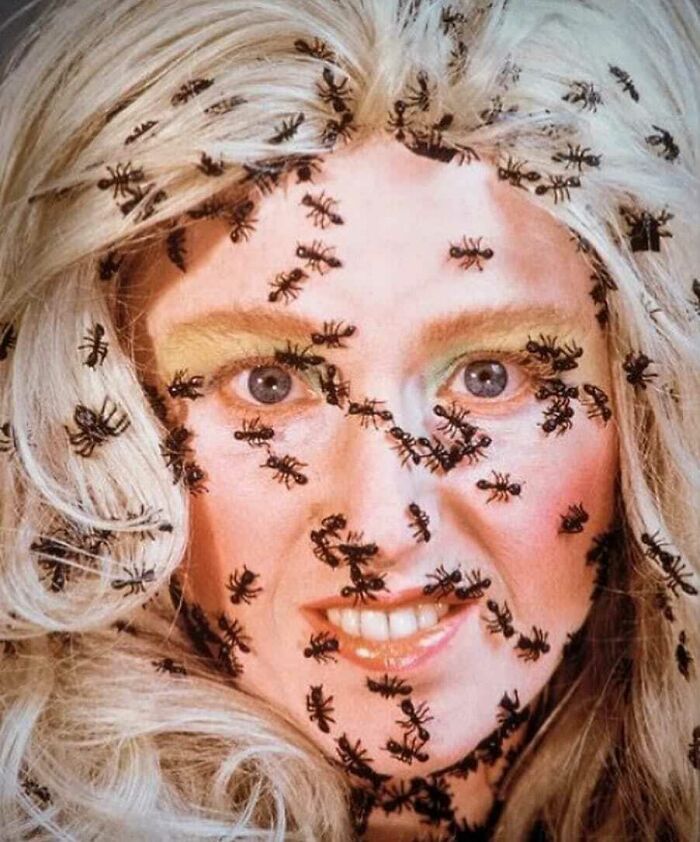
Image credits: The Museum of Ridiculously Interesting Things
#24 A Tiny Devil Vitrified In A Prism Of Glass
In the 18th century, the Imperial Treasury of Vienna attested that this was a real demon which had been trapped in glass during an exorcism in Germany a century earlier. I personally recommend selling all your cryptocurrency and investing in demon crystal instead. From the Kunsthistorisches Museum Collection, Vienna
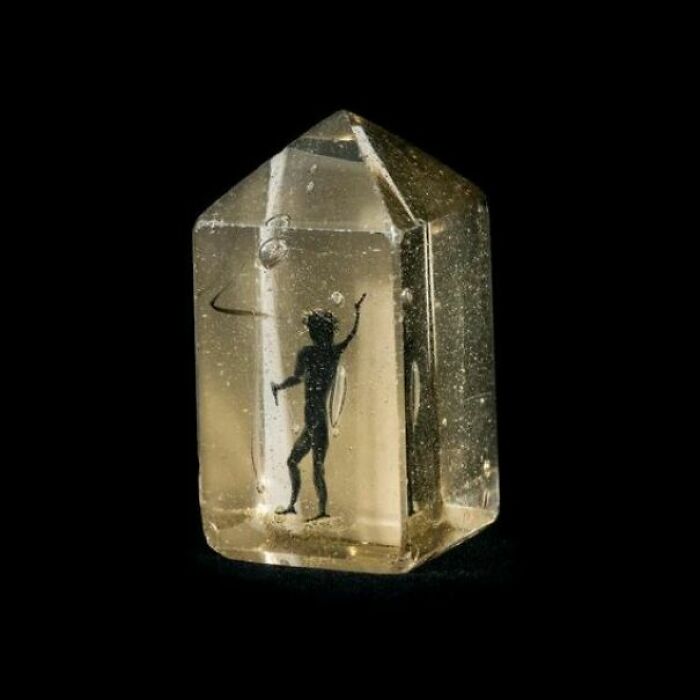
Image credits: The Museum of Ridiculously Interesting Things
#25 Vintage Halloween Lantern In The Shape Of A Foot With Deranged Smiling Face
Made by the Basic-Witz Furniture Industries Inc. in Waynesboro, Virginia. Via Morphy Auctions, Pennsylvania.
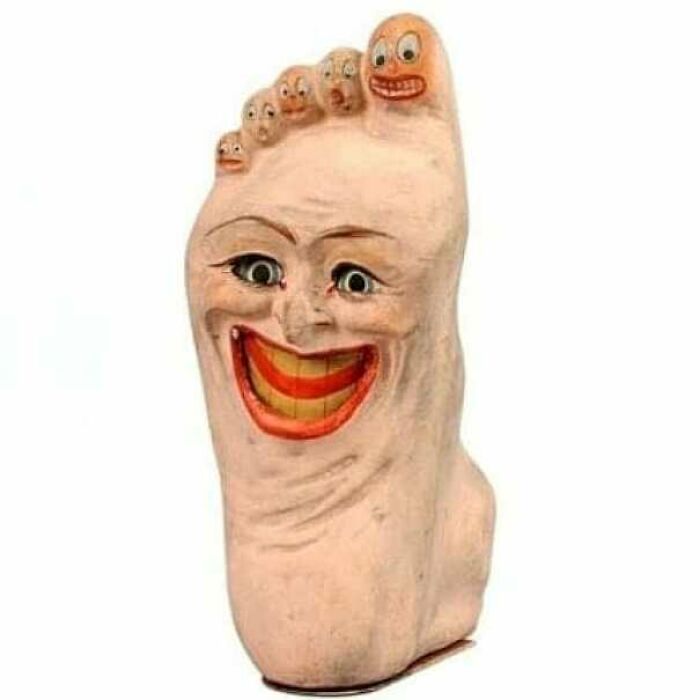
Image credits: The Museum of Ridiculously Interesting Things
#26 Mechanized Gorilla Teeth And Head Gear Worn By Gorilla Impersonator Ray 'Crash' Corrigan In White Pongo (P.r.c. Pictures, 1945)
The metal armature and resin teeth were fastened around the actor's face, to sit underneath his rubber gorilla suit. Wires and levers attached to his jaw and cheeks would make the gorilla nostrils snort, the mouth open and the lips snarl.
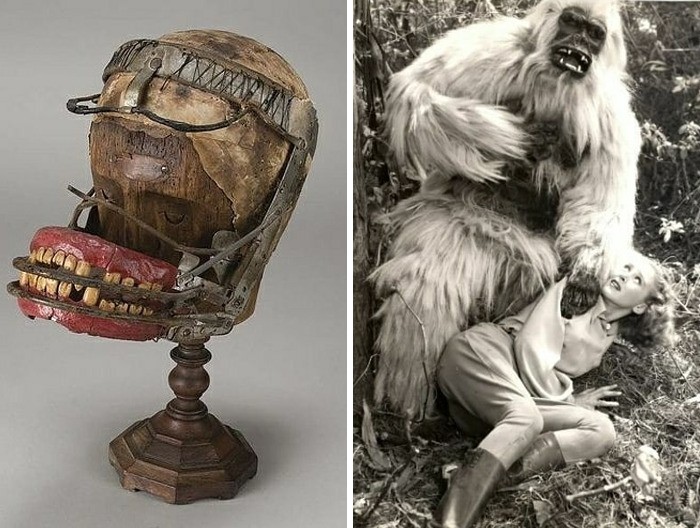
Image credits: The Museum of Ridiculously Interesting Things
#27 In Douglas Gordon's Series 'Self Portrait, You + Me', The Artist Poured Egg White And Sugar On The Eyes, Noses And Mouths Of Celebrity Movie Posters
He then ritualistically burnt their faces with a blowtorch or candle...a twisted occult ritual meets celebrity crème brûlée. Gordon places the deformed pictures onto a mirrored surface, so that the viewer is forced to see themselves reflected back in the mutilated and monstrous faces. Inspired by Andy Warhol's obsession with famous faces in Pop Art, Gordon's work presents celebrity worship as a dark and obsessive form of self-torture. /// Douglas Gordon, selected works from 'Self Portrait, You + Me' (circa 2006-07), burnt gelatin silver print ash on mirror
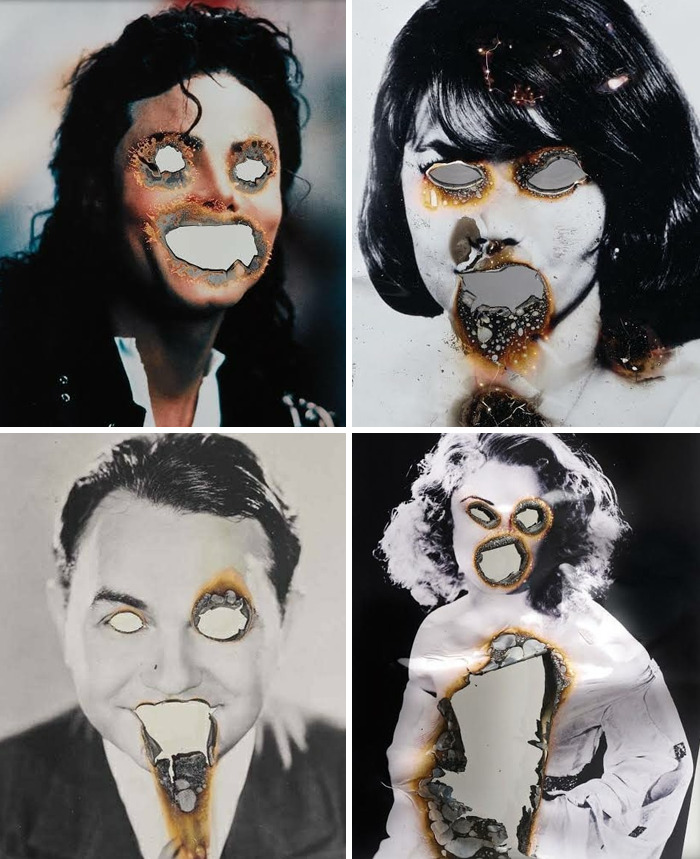
#28 Hard Plastic Dolls From The 1940s And 50s, Who Are All Suffering From Sad Doll Disease. This Is A Real Thing And It Is Actually Infectious
Sad Doll Disease happens to dolls made from early hard plastics, due to a chemical reaction between the cellulose acetate and the iron pins that hold their eyes in. Infected dolls start to ooze brown viscous tears, their heads warp and crack, and they begin to emit a horrible vinegar stink. Basically, this condition turns old dolls into living nightmares. The weirdest part is that Sad Doll Disease triggers the same chemical chain reaction in other hard plastic dolls. The infectious dolls therefore have to be quarantined away from other dolls, or they too will catch it and begin to degrade. There is no cure
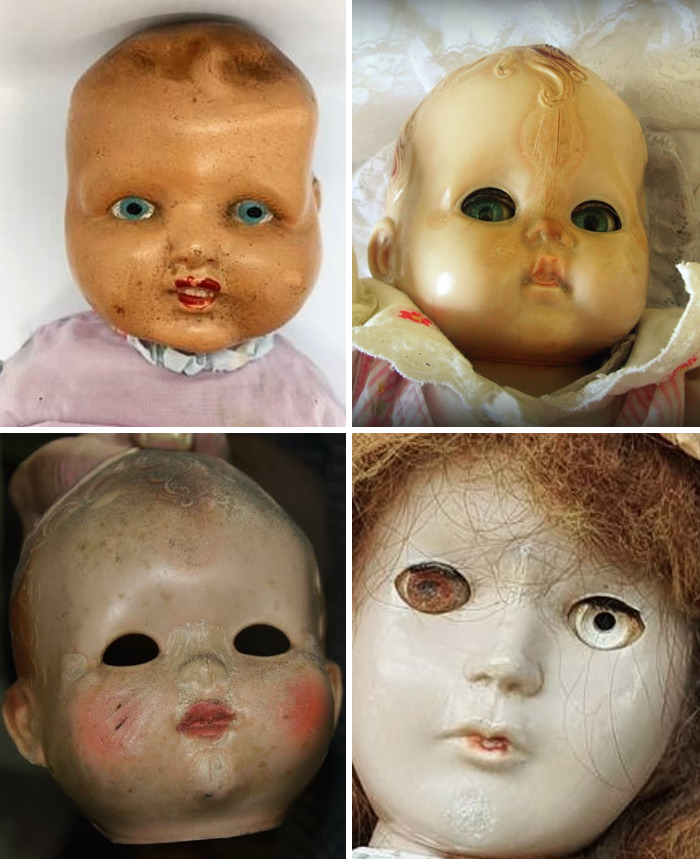
#29 Frans Snyders (1579-1657), 'Studies Of A Cat's Head', Oil On Canvas. Hermitage Museum, St. Petersburg
A little known fact about this painting is that this cat's mama just killed man. Put a gun against his head, pulled the trigger now he's dead
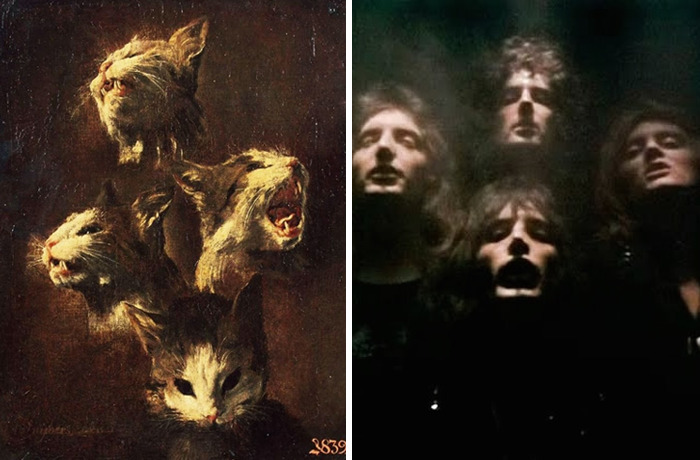
Image credits: The Museum of Ridiculously Interesting Things
#30 Dr. Wansbrough's Celebrated Nipple Shields, Late 19th C
For Protecting Sore Nipples From Teething Babies, And Also For Protecting Paranoid Breasts From The Telepathic Electromagnetic Waves Of Extraterrestrials
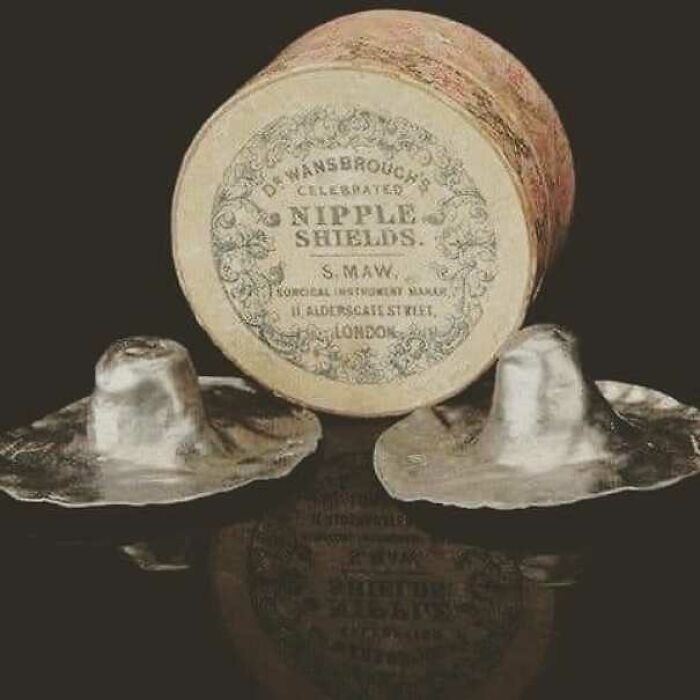
Image credits: The Museum of Ridiculously Interesting Things
#31 Here's Something You Didn't Know You Needed In Your Life: Teeny Tiny Pig Porn
Made in the early 20th century, these little gold-painted pig charms hide a tiny erotic photo viewed by peering into the pig's butthole. These charms contain a hidden Stanhope lens -- a one-piece microscope used for viewing tiny microphotographs as small as the head of a pin. From the late 1850s, it became trendy to embed Stanhopes in everyday items like pocket watches or thimbles, often sold as holiday souvenirs with pictures of popular tourist scenes. But humans be humans and it didn't take long for someone to figure out this was also a great way of hiding porn. I'm not entirely sure why golden pig charms became a particular thing, except that pigs are particularly associated with male lust. (Hence why chauvinist men are called 'pigs'. See also: the weirdly seductive Miss Piggy.) The first pig charm that I've pictured is actually for sale at St Eloi Vintage. However, be warned that it is coated in lead paint, so if you don't want to risk lead poisoning you may be better off getting your porn from the old-fashioned internet rather than the butthole of a tiny gold pig
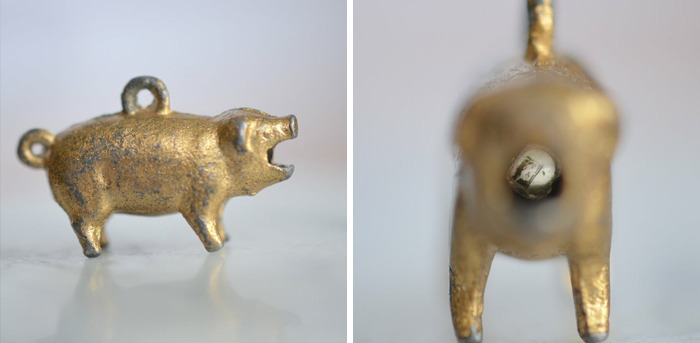
Image credits: The Museum of Ridiculously Interesting Things
#32 This Valentine's Day, Give Her What She Really Wants: A Tissue Sample From The Shower Of Mysterious Meat Chunks That Rained Down On Bath County, Kentucky In March 1876
Witnesses at the time (including some brave idiots who tasted it) thought the meat might be mutton or veal. One scientist suggested it was half-digested meat vomited up by vultures flying overhead. But no one knows for sure. // Jar with preserved 'meat rain' sample from the Arthur Byrd cabinet at Transylvania University, Kentucky.
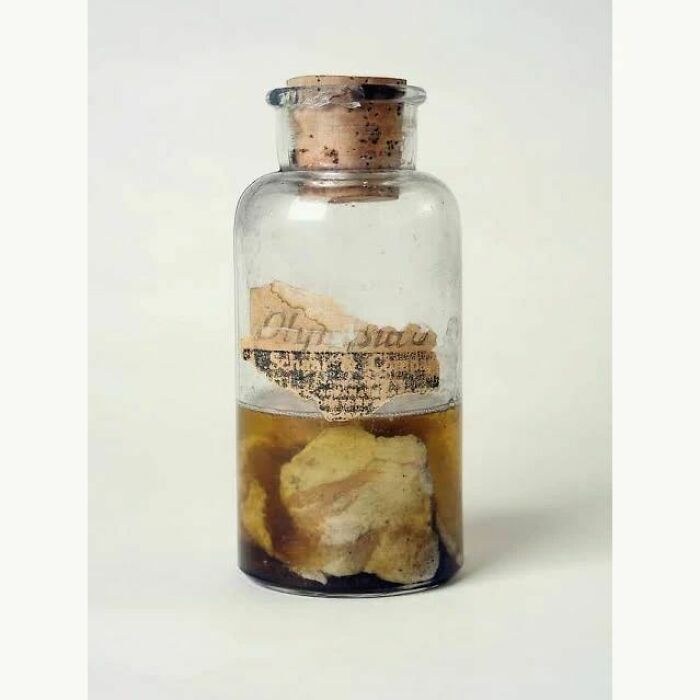
Image credits: The Museum of Ridiculously Interesting Things
#33 A Late 19th Century Wax Head From Berlin Which Was Stored Face-Down For Many Years, So That It Deformed Into This Exquisitely Grotesque Nightmare
From the marvellously creepy Museum of Fear and Wonder in Alberta, Canada. Normal people might find this flattened wax face unsettling, but it will give museum people utterly ghastly nightmares about bad storage conditions.
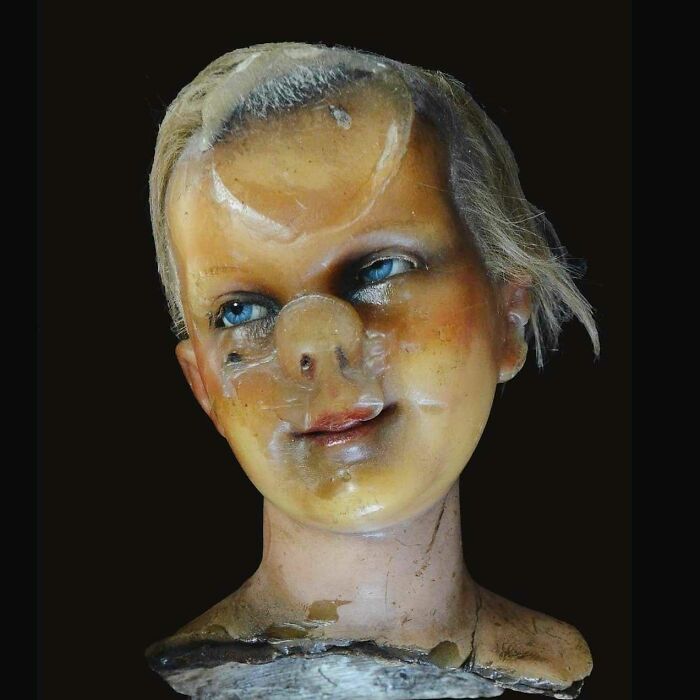
Image credits: The Museum of Ridiculously Interesting Things
#34 Terrifying Example Of A Traditional Irish Jack-O'-Lantern Carved From A Turnip, Circa 1850
Preserved all these years by the tears of children, I presume. From the collection of the Museum of Country Life, Ireland.
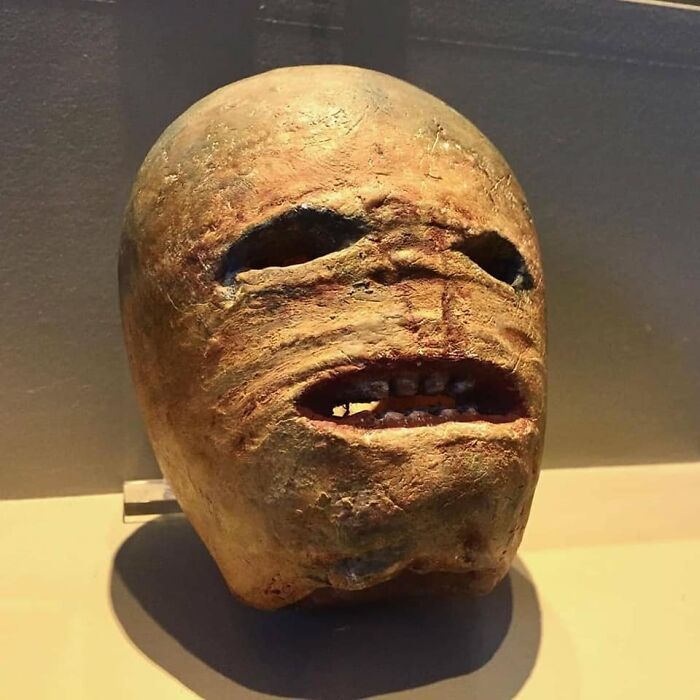
Image credits: The Museum of Ridiculously Interesting Things
#35 Painted Tin Mask, Made By Unknown Folk Artist In Bolivia Around 1950-1960
Perhaps this is what inspired Dr. Seuss to write The Cat in the Hat, except he left out the part at the end where all the kids have to get a tetanus shot. From the San Antonio Museum of Art.
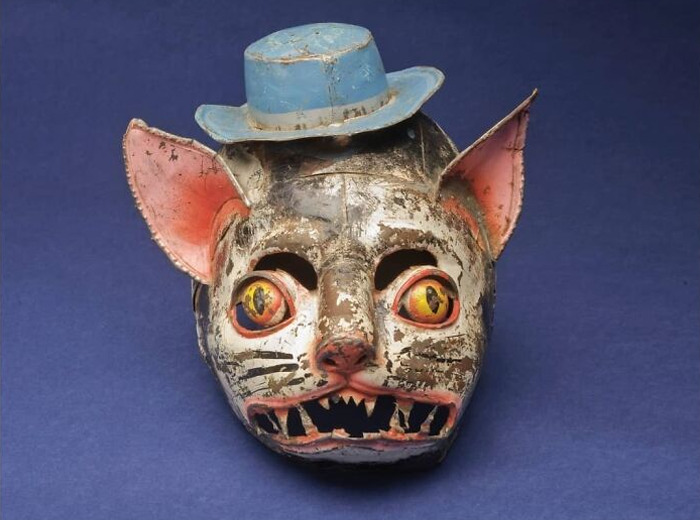
Image credits: The Museum of Ridiculously Interesting Things
#36 A Brown Velvet Hat That Belonged To A Street "Dentist" Or Travelling Tooth Puller In London In The 1820s-50s
It is decorated with 88 decayed human teeth from his former patients, each drilled with a hole and attached with twine. In the days before anesthetic, this cap was meant to reassure potential clients that the dentist had "magician-like" skills, and could magically remove your rotten tooth without pain or infection. He couldn't. Despite his magical tooth hat, the procedure would hurt like bloody screaming hell as he yanked your decaying molar out of your mouth with his rusty germ-infested tools. But at least you could take a little comfort in the fact that your dentist looked GREAT. From the Cuming Collection of the Southwark Heritage Archives, London, UK.
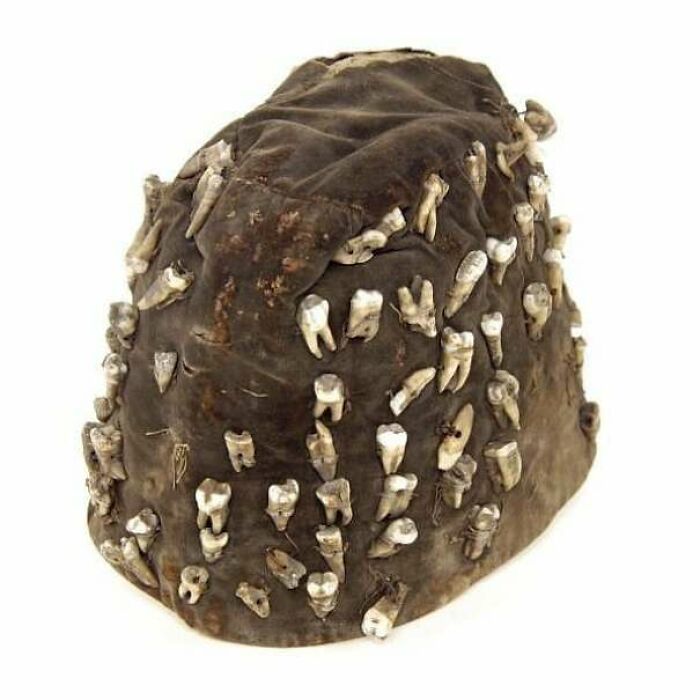
Image credits: The Museum of Ridiculously Interesting Things
#37 This Goat's Mouth Might Be A Portal To Hell, And It Is Most Definitely A Portal To My Heart
Eric Lee-Johnson, 'Billy goat, Northland' (c.1958), gelatin silver print. Collection of Museum of New Zealand Te Papa Tongarewa.
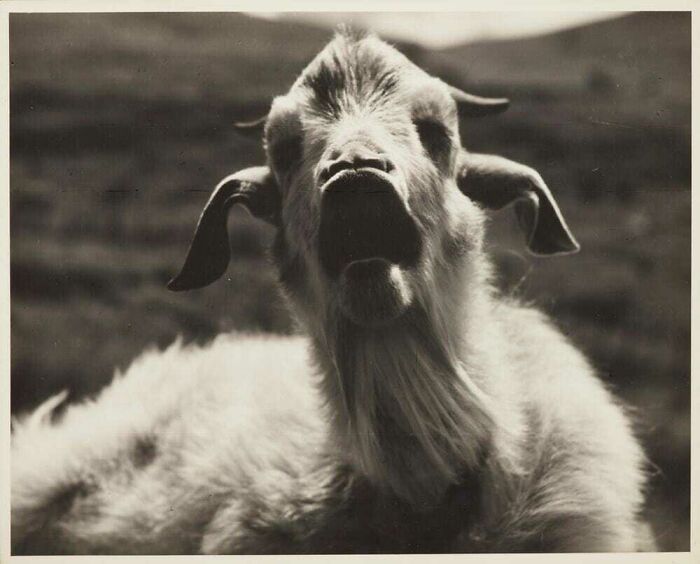
Image credits: The Museum of Ridiculously Interesting Things
#38 Amazing Vintage Krampus Gloves
These frightening homemade claws come from a small town in Austria, where they were used at an annual Krampus Festival for over 70 years. They are made from goat hair, antlers, and the bitter regrets of naughty children. A German children's rhyme has been handwritten on the palms of the gloves, with a translation provided by the original seller @tiffasaurus.rex : /// Hey kids – if you cheat your father, mother, and friends; If you make noise in the school like you are in a flea market; If you are really noisy like that, then I know I must come to scare you! BUT if you are good children and don’t make any of the above and don’t lie, We will enjoy this party together and flourish! ///
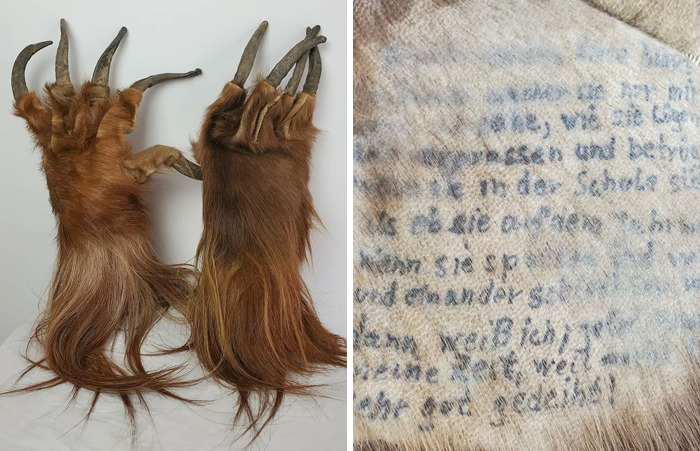
Image credits: The Museum of Ridiculously Interesting Things
#39 Here Are Some Magic Potatoes
They can't magically fix election anxiety but were once believed to help with rheumatism. The catch was that the potatoes had to be stolen. Dug up from fields at nighttime or pinched from a greengrocer, the stolen potato would then be worn against the body in a special pocket or bag with the hopes it would absorb the inflammation from the wearer's achy joints. These magic potatoes were donated to the Pitt Rivers Museum in Oxford in the 1890s. I already know that some of you are going to ask why the century-old potatoes haven't rotted. The answer is obviously "Magic, duhhhh."
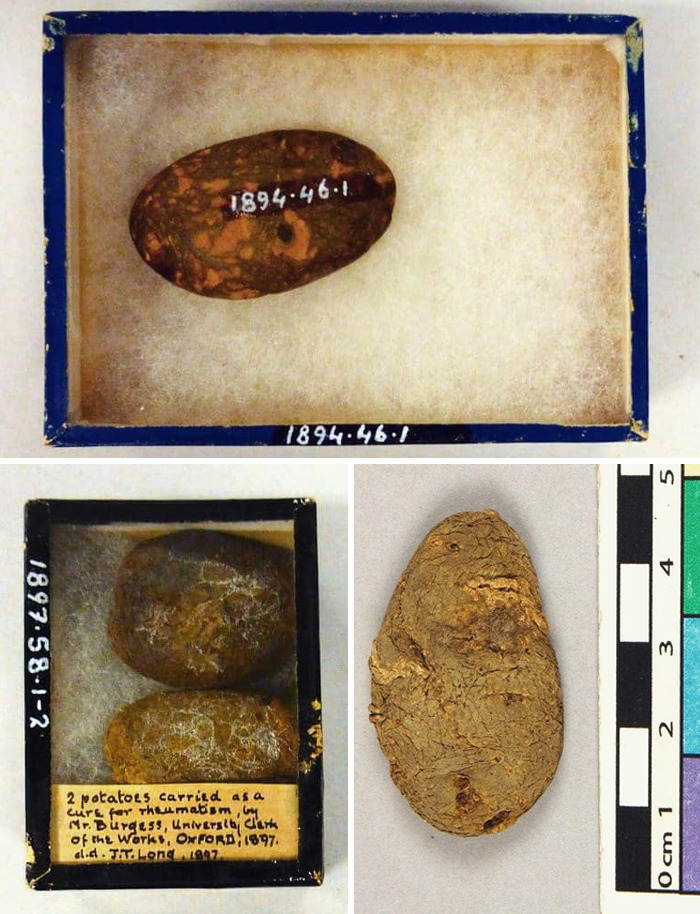
Image credits: The Museum of Ridiculously Interesting Things
#40 Keep Your Face Looking Youthful By Washing It With The Tears Of Children!
Norton's "Smile and Cry" baby face soap with face flannel, 1930-39. There is a laughing face on the other side of the baby's head and I honestly don't know which option is worse. Either way, this weird fleshy soap is only going to get more horrifying as the face becomes gradually more deformed every time it is used. From the collection of the Victoria & Albert Museum.
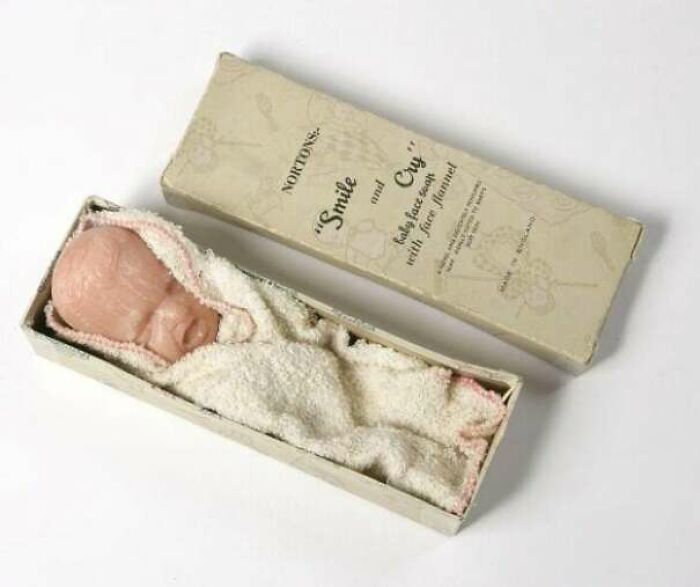
Image credits: The Museum of Ridiculously Interesting Things
#41 A Posthumous Portrait Of A Child Holding A Lizard, Which Sheds Its Skin And Regrows Its Tail -- A Symbol Of Resurrection, Rebirth Or Regeneration
This late 19th or early 20th c. American folk painting is currently being sold at Christie's. In the auction notes, they speculate that instead of a lizard, the dead child is actually holding a baby caiman -- a creature similar to an alligator from Mexico and South America. But why memorialize a dead child this way? A lizard is frankly strange enough, but at least the symbolism makes a sort of sense. But alligators and crocodiles really only appear in the history of art as stand-ins for demons and other creatures of Hell. It certainly gives the child's piercing stare dark new depths. Perhaps the child meant to be posed as an angelic figure, his hands gripping the throat of the demonic animal? Or maybe caimans were simply the kid's favourite animal? Hopefully, it is not a clue to this child's untimely demise...
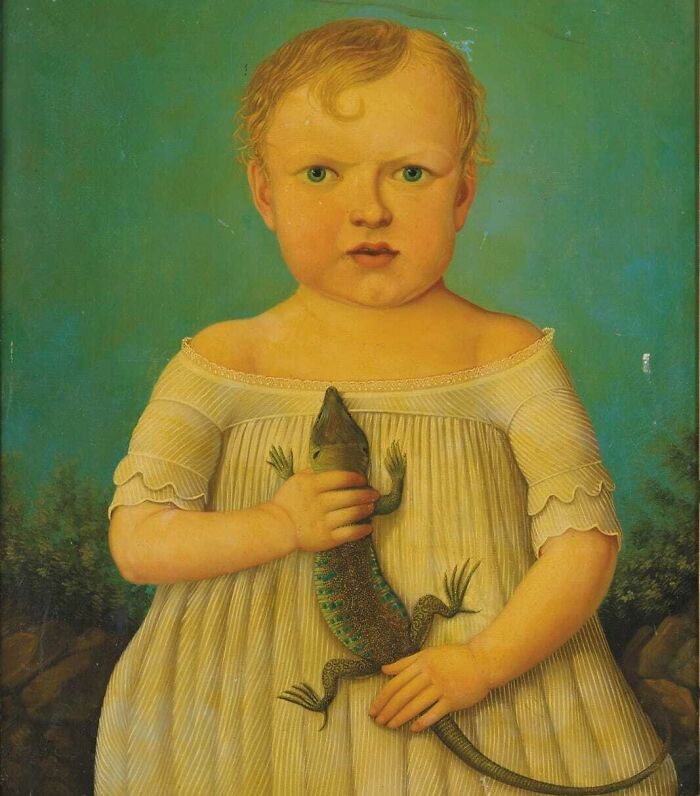
Image credits: The Museum of Ridiculously Interesting Things
#42 A Gruesome Staffordshire Pottery Figurine Of A Tiger Mauling A Woman And Her Baby, C. 1834
In February 1834, a lion and a female tiger escaped from Wombell's Travelling Menagerie when the show was parked up overnight in a town in Northumberland, UK. Before the animals could be recaptured, the tigress killed a woman with a child in her arms. The owner of the travelling menagerie supposedly bribed local newspapers to keep the incident quiet in the press...but clearly he forgot to pay off the ceramicists.
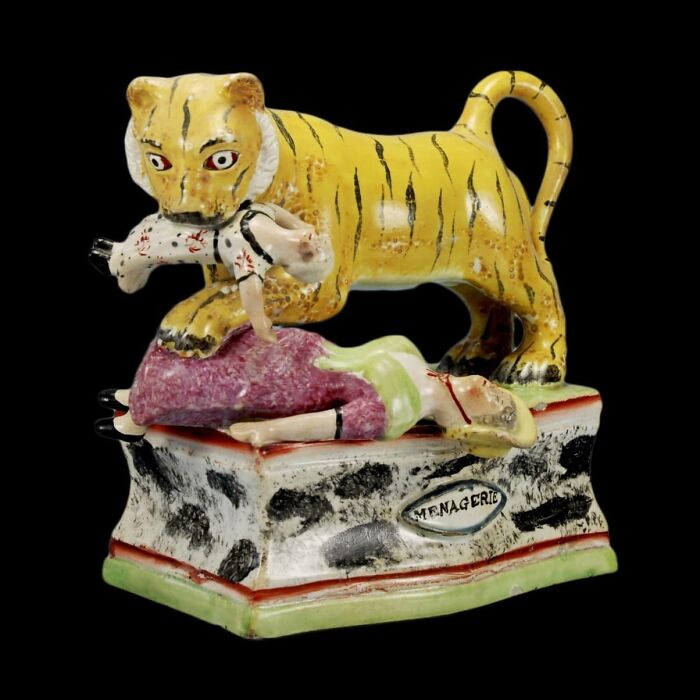
Image credits: The Museum of Ridiculously Interesting Things
#43 Wax Model Of A French Sailor With Skin Disease Of The Nose, Made In 1894
The unusual bulbous growths on his nose tells us that he has an inflammatory skin condition called rhinophyma. The pipe tells us that he's jaunty. From the National Museum of Health and Medicine in Maryland, USA.
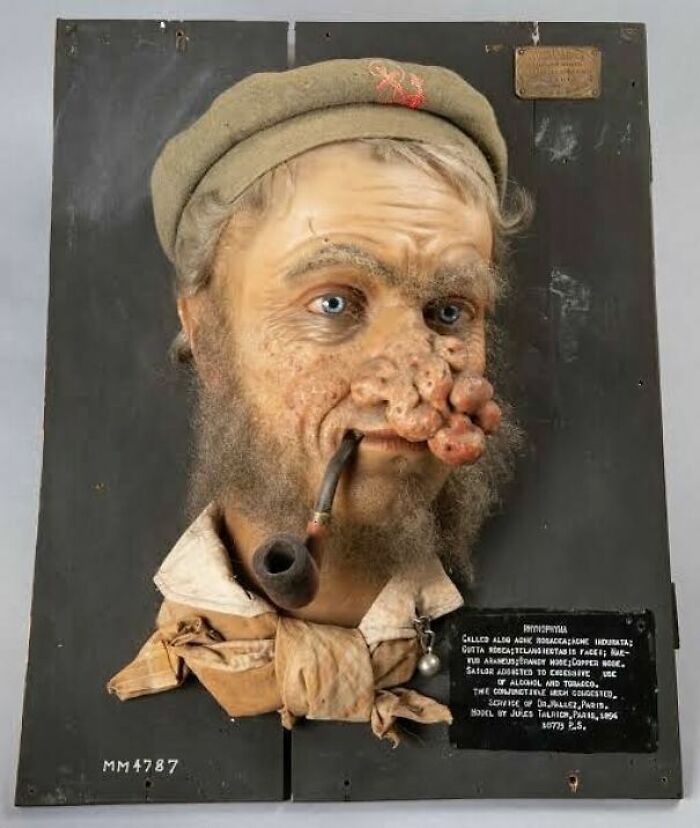
Image credits: The Museum of Ridiculously Interesting Things
#44 A 15th Century Painting Of St Bartholomew Wearing His Own Flayed Skin As A Robe After Being Skinned Alive And Honestly He Is Totally Pulling Off The Look
Matteo di Giovanni, 'St Bartholomew' (c. 1480-85), tempera and gold on wood. Museum of Fine Arts, Budapest
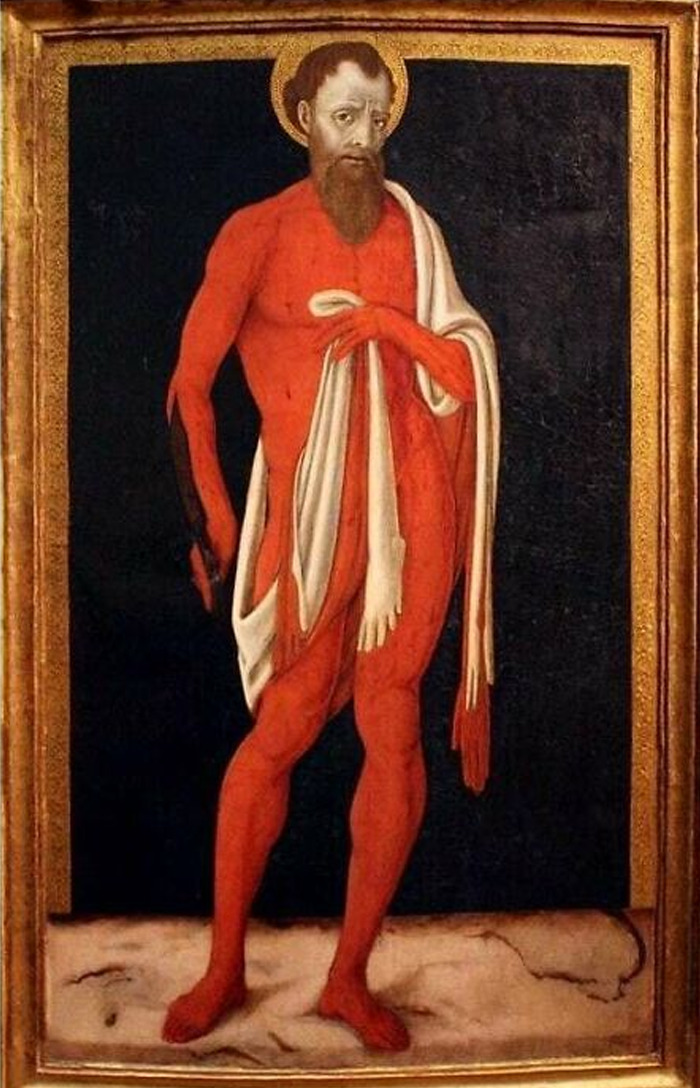
Image credits: The Museum of Ridiculously Interesting Things
#45 "Dental Plumper" Jaw Prosthetic Worn By Marlon Brando In The Godfather (1972)
Brando wanted Vito Corleone to have jowls like a bulldog, so he stuffed cotton balls in his mouth during his audition. This dental plumper was designed by legendary makeup artist Dick Smith, and made by a New York dentist named Henry Dwork. Their first prototype used more comfortable foam latex, but it made Brando's face look too soft and droopy, so he had them remake it in steel and resin. This jaw prosthetic must have made Brando extremely drooly, much like the bulldogs he sought to resemble. From the American Museum of Moving Image in Queens, New York
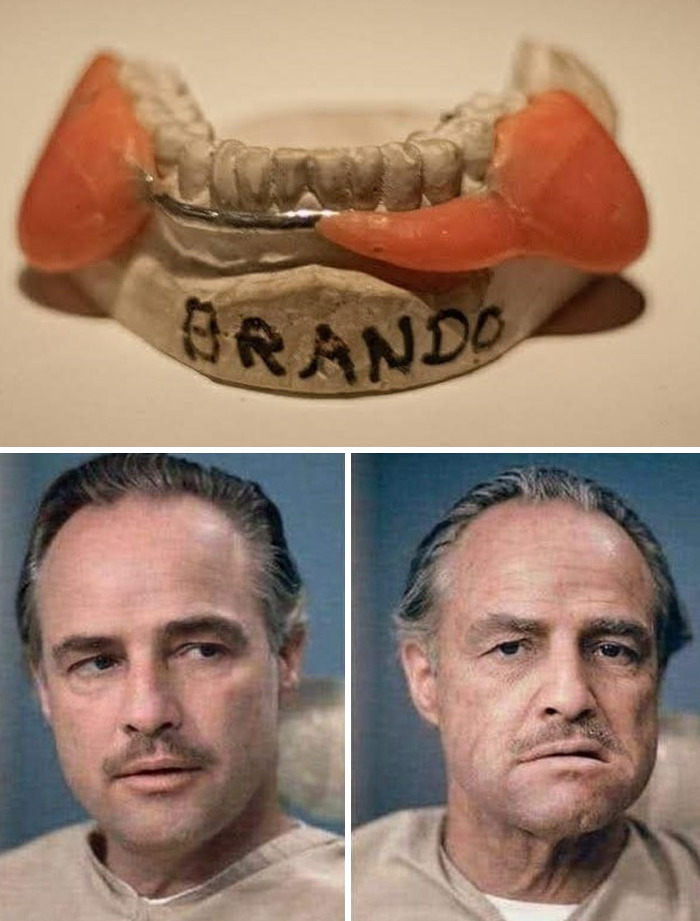
Image credits: The Museum of Ridiculously Interesting Things
#46 Artificial Leg Made Out Of The Fuselage Of A Crashed Plane
This homemade prosthesis was made during WWII by a resourceful group of British prisoners detained in a Japanese POW camp in Singapore in 1943. In the forced labour camp, survival depended on a prisoner's ability to work. So this leg made of aircraft debris would have saved the life of a fellow prisoner who had lost his leg. Historians speculate that the odd shade of pink was the closest paint colour that the prisoners could find to match the skin of the injured soldier. Or possibly he was just feeling fancy. From the collection of the Science Museum, London
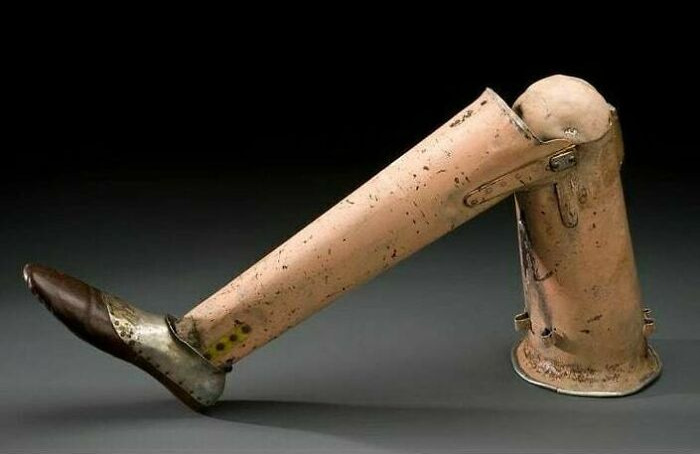
Image credits: The Museum of Ridiculously Interesting Things
#47 Need A Fresh New Look? 19th Century 'Fungus Oculi' Illustration Showing Off All The Hottest Eye Fungus Looks This Season
From the James Moore Bell Opthalmology collection at the National Museum of Health and Medicine, Maryland US.
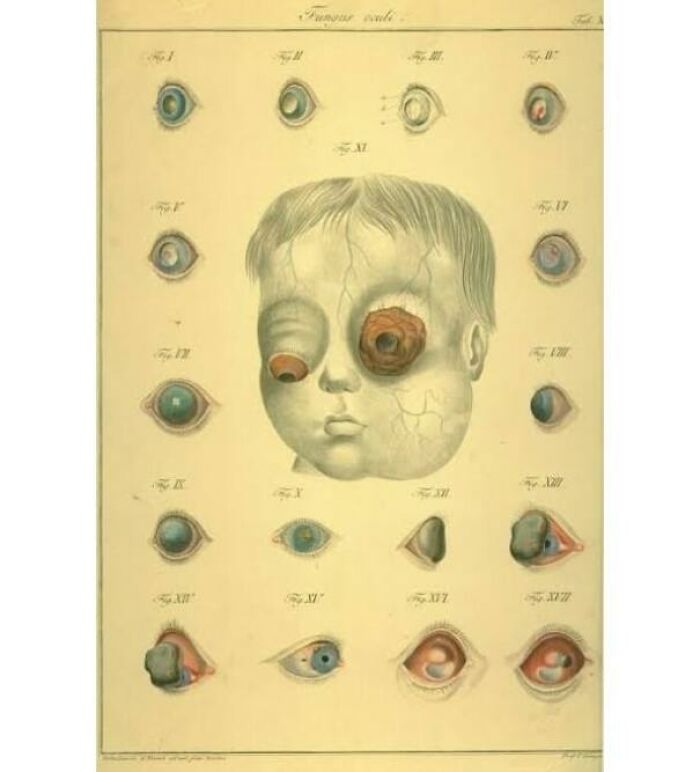
Image credits: The Museum of Ridiculously Interesting Things
#48 In Egon Schiele's 'Dead Mother' Series (1908-14) The Artist Paints Himself As A Terrified Baby Being Smothered By A Decaying Corpse Or Demonic Mother
Trapped in the womb or in mommy's smothering embrace, these creepy self-portraits are full of anxiety. The artist-baby locks eyes with the viewer, raising his hand in a desperate plea for help. In Schiele's work, mothers are certainly not symbols of comfort and nurturing, but of the inescapable grip of death on our lives. Schiele had a troubled relationship with his own mother (surprise surprise). He deeply resented her lack of grief at the death of Schiele's father, who died of syphilis when the artist was young.
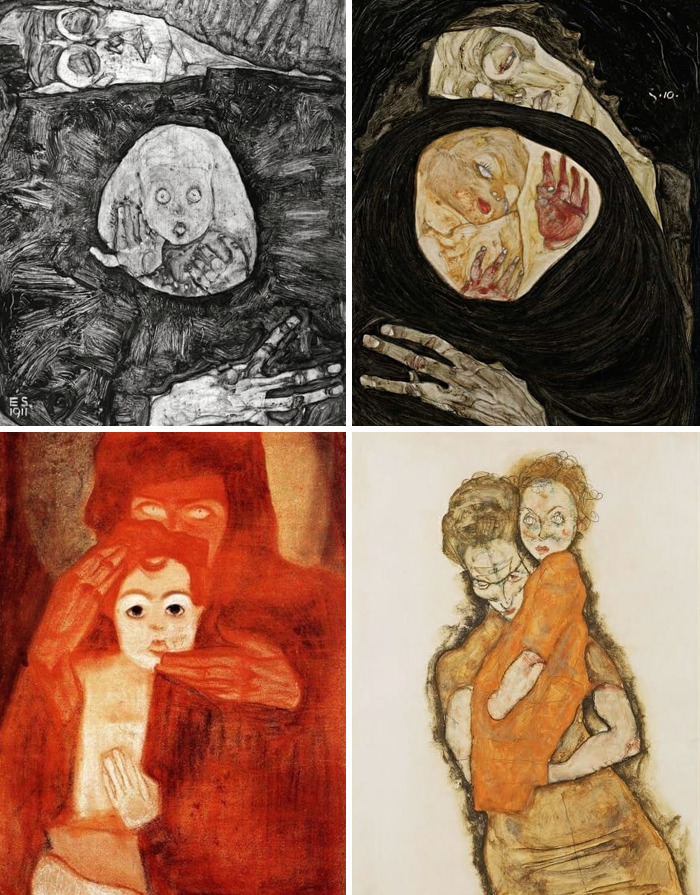
Image credits: The Museum of Ridiculously Interesting Things
#49 Folk Art Wood Carving Of An Exorcism Scene, With A Demon Sitting On Top Of A Terrified, Wide-Eyed Child
Made around 1910 in the mid-western United States by an unknown artist. It was up for sale at Sotheby's in 2019 with an estimated price of $40,000 - $60,000 USD. I know that sounds like a really steep price, but this is a high-quality family heirloom that you can hand down to your grand-demons and great-grand-demons one day, so it's definitely worth it.
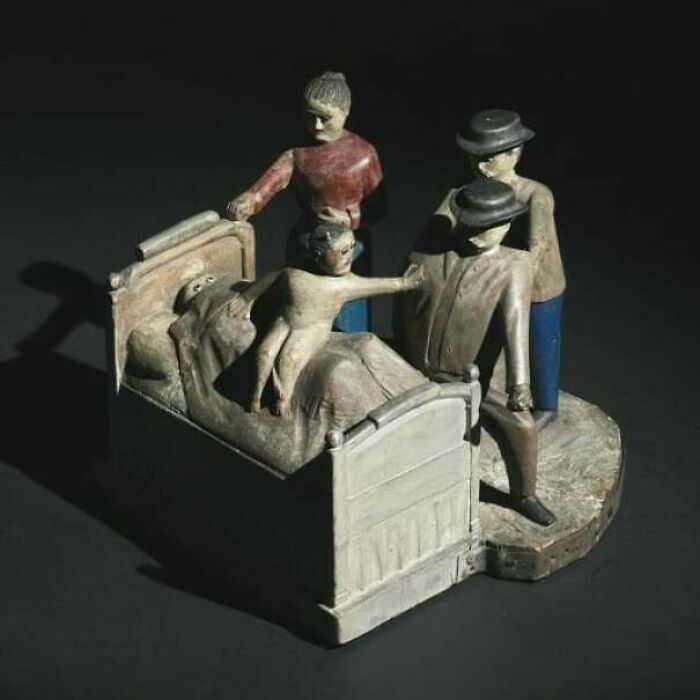
Image credits: The Museum of Ridiculously Interesting Things
#50 This Creepy Potato Man Is Part Of A Series Of Menacing Vegetable-Themed Valentine's Day Cards Designed In 1911 By American Illustrator Bernhardt Wall
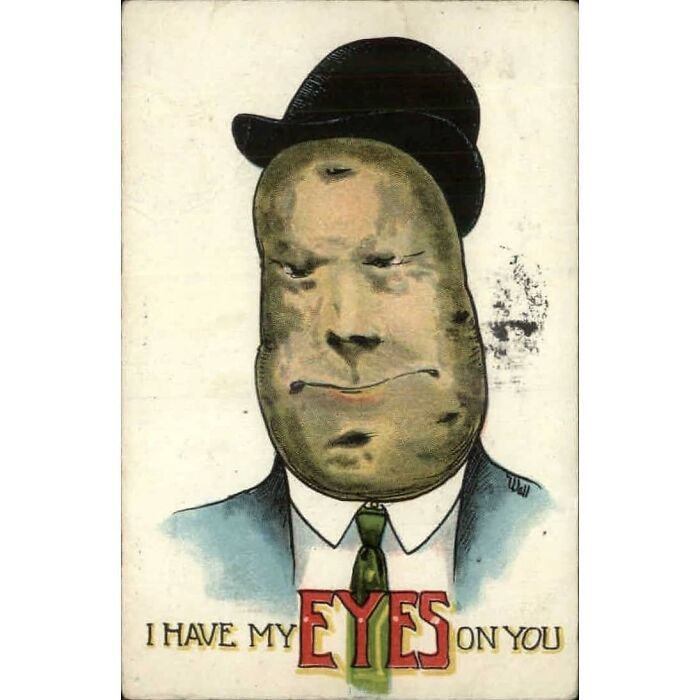
Image credits: The Museum of Ridiculously Interesting Things
#51 The Nightmarish Dolls Of French Outsider Artist Michel Nedjar, Made From Fabric Scraps Coated With Mud And Blood, C.1976-82
Resembling mutilated bodies and burnt corpses, Nedjar's haunting dolls are meditations on the horrors of the Holocaust. The self-taught artist was born in France in the aftermath of WWII, to a family of Jewish immigrants whose close relatives had largely been wiped out in the concentration camps. As a child, he developed an obsession with textiles and would accompany his grandmother selling rags at Paris flea markets. Following a period of deep depression in the late 1970s, Nedjar began making these grotesque dolls from scraps of fabric coated with mud and blood, as a way of confronting his grief, terror and rage about his family's tragic history. Collection of L'Art Brut in Lausanne, France.
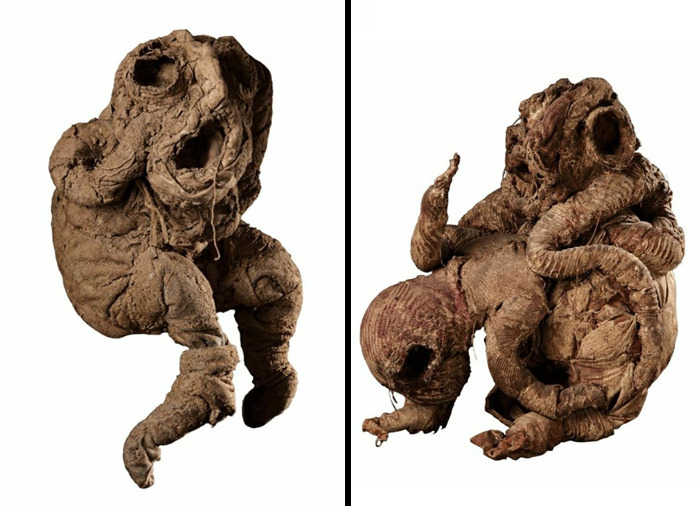
Image credits: The Museum of Ridiculously Interesting Things
#52 A Fascinating Illustration From 1909 Showing The Effects Of Syphilis On Tattooed Skin
The eruptions are only visible on the blue ink because the red pigment was made from cinnabar (mercury sulfide) -- used in the treatment of venereal diseases before the advent of penicillin. Although some claimed short-term relief from mercury treatments, it was unfortunately not an effective long-term treatment. Syphilis sufferers would eventually succumb to the ravages of the disease...but only if mercury toxicity didn't kill them first.
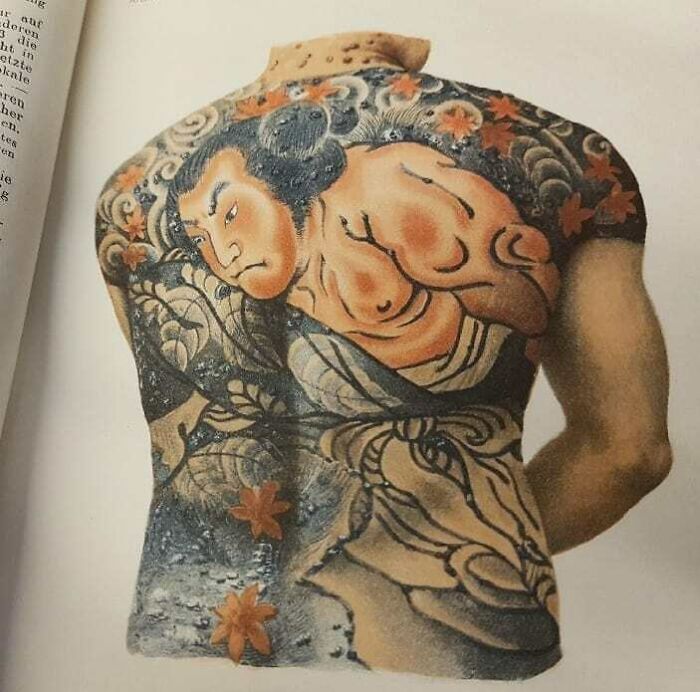
Image credits: The Museum of Ridiculously Interesting Things
#53 Michelle The Choking Doll, 1930s
This hand-sewn doll was used by pioneering surgeon Chevalier Jackson (1865-1958) to demonstrate techniques for removing objects from small children's throats. She has a teeny homemade trachea and esophagus sewn in her throat, and a scar on her neck where the doctor once performed an emergency tracheotomy on her. -- Collection of the Mütter Museum, Philadelphia.
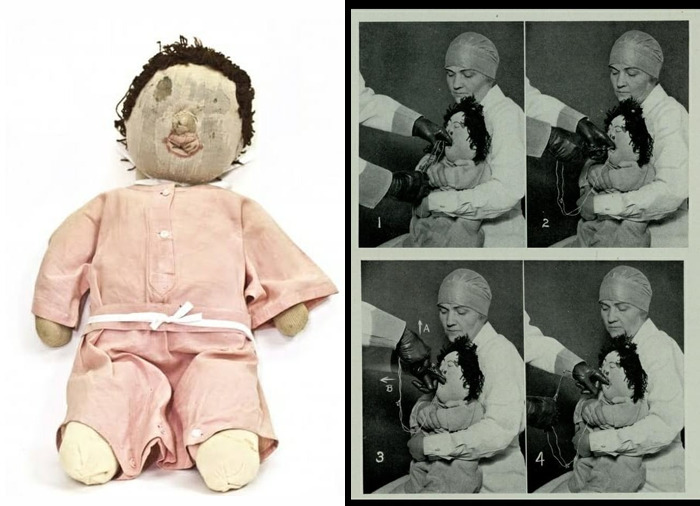
Image credits: The Museum of Ridiculously Interesting Things
#54 In The 1960s, A Chicago Bellhop Named Ted Serios Claimed He Could Record His Thoughts On Polaroid Film Using Only Psychic Powers
To make these "thoughtographs" he would point his forehead toward the lens of the camera, producing a dark and blurry image of his thoughts. Apparently, the process only worked when Ted was very drunk. What makes this story extraordinary is that the photos were endorsed as genuine by a Denver psychiatrist named Jule Eisenbud, who studied Ted for three years. Experts later dismissed both the images and the psychological study as hoaxes...but to many, it was enough to give the thoughtographs real credibility.
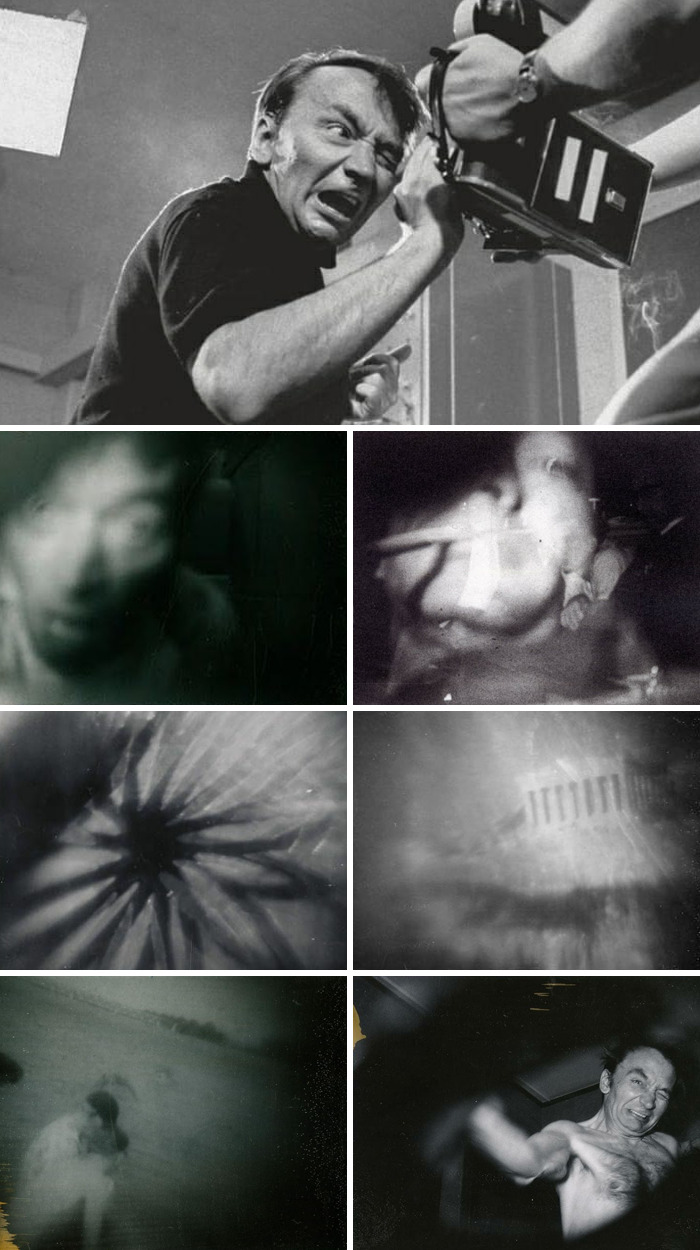
#55 "Model Citizen" (2018) By Lee Harper @historybones -- A Hand-Crafted Skeleton Diorama Of Serial Killer John Wayne Gacy Applying Clown Makeup In The Mirror
Lee Harper is a Mississipi-based artist who makes creepy miniature dioramas of true history, starring tiny sinister skeletons. "Model Citizen" takes its inspiration from the seemingly 'ordinary' life of John Wayne Gacy, who managed several KFC restaurants and performed at children's birthday parties as Pogo the Clown...when he wasn't murdering dozens of young men and boys. Harper's work emphasizes the banality of evil -- the idea that the scariest people are sometimes hidden in plain sight. I particularly love the detail of the half-eaten bucket of chicken. Gacy requested KFC as his last meal before being executed on death row in 1994.
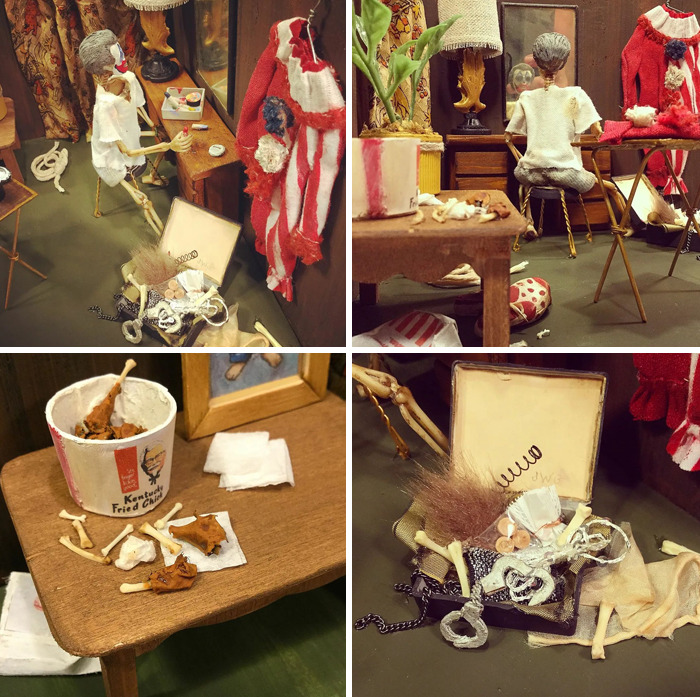
Image credits: The Museum of Ridiculously Interesting Things
#56 Whenever Someone Describes Themselves As A Dog Person, This Is What I Think Of
In the 1950s, American Surrealist Dorothea Tanning really got into making art about her pet Lhasa Apso and Pekingese dogs. But these weren't your typical cutesy puppy pictures -- Tanning's dogs have a creepy intensity and strange human body parts. In her work, these monstrous dogs became a way of exploring female sexuality, domesticated desires and the sensual pleasures of fur.
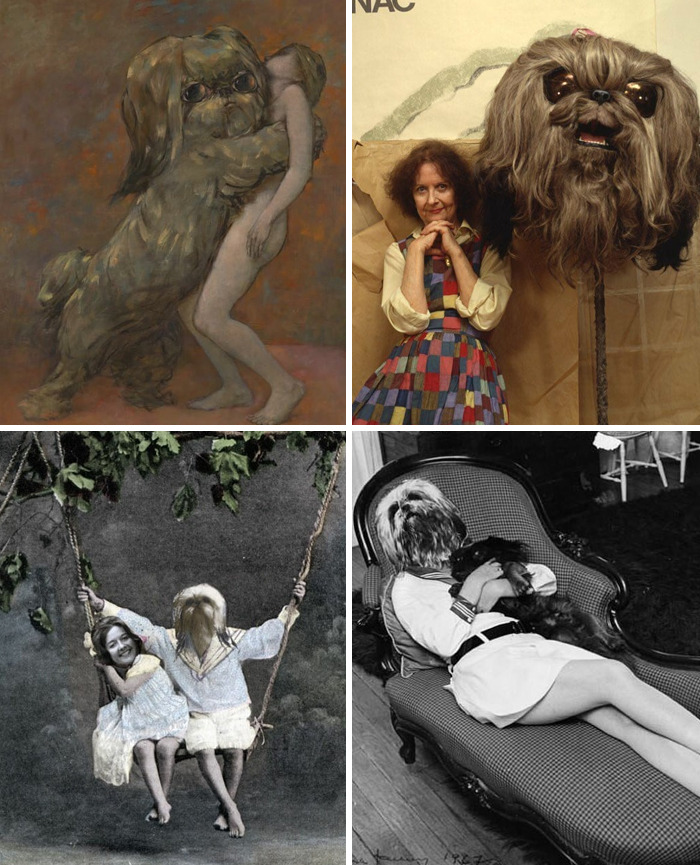
Image credits: The Museum of Ridiculously Interesting Things
from Bored Panda https://bit.ly/3N0Y9rz
via Boredpanda